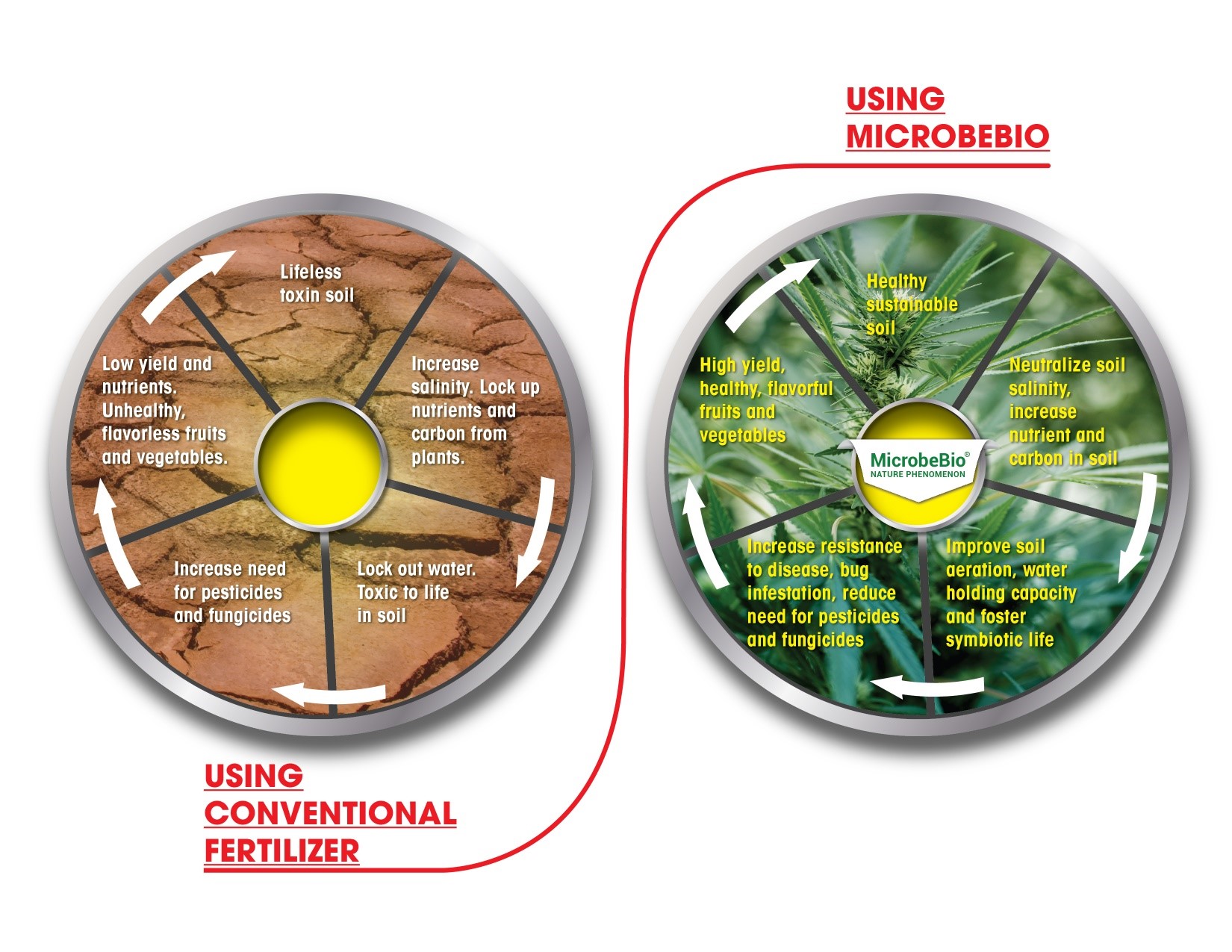MICROBEBIO® PRODUCTS
GROWING CANNABIS AND HEMP
WHY CHOOSE MICROBEBIO® PRODUCTS FOR CANNABIS AND HEMP:
Deep down within the soil, there are a whole bunch of essential microbes that consists of fungi and bacteria. These microbes play a vital role in the overall development and growth of your cannabis plant.
Having said that, the idea of bacteria aiding nutrition to the cannabis plants might seem strange to you. But do remember that the human body also contains several bacteria to keep it healthy. Of course, humans are not made of soil. Therefore, things do not exactly work in the same fashion. But the microbes in our guts and those found in the soil share key common functions.
Essential microbes in the soil help in breaking down the available nutrients. This breakdown of substances helps the cannabis plant roots to increase their uptake of beneficial nutrients more efficiently.
The proprietary probiotics and beneficial microbes push the plant to produce homes and secondary metabolites that stimulate and increase the THC synthase enzyme and CBD synthase enzyme. These are the natural enzymes found in all cannabis plants that produce the oils, terpenes (flavor and aroma), flavonoids (antioxidants), root health, and plant nutrient density.
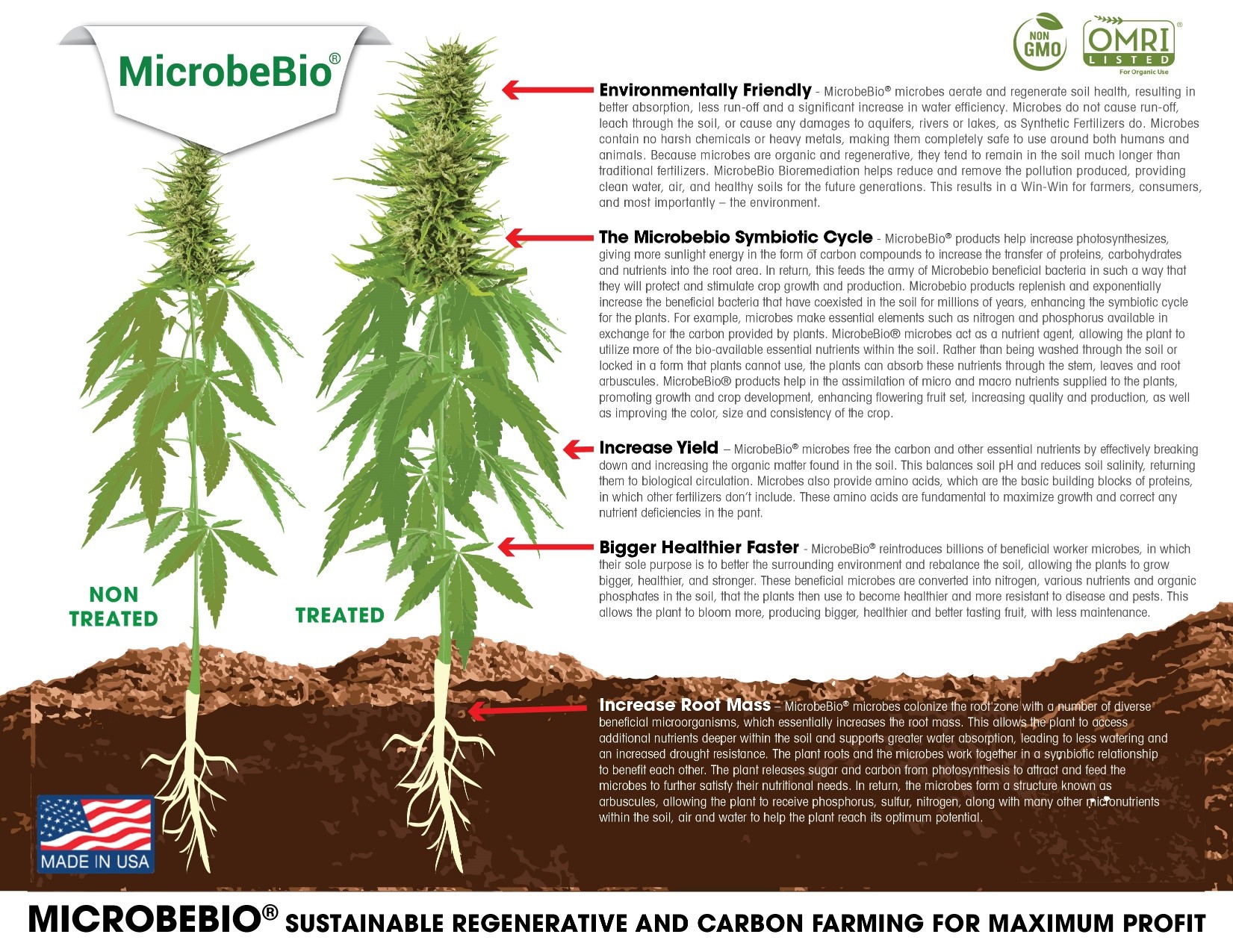
QUANTITY
Normally, there are 1,000 to 4,000 cannabis plants (with the ideal distance from 3 to 5 feet) per acre depending on the type of cannabis the growers choose. Some experts suggest growing from 2,000 to 2,500 cannabis plants per acre may be achievable. So, for growing cannabis on a big farm, the growers need to prepare the best and enough seeds to grow.
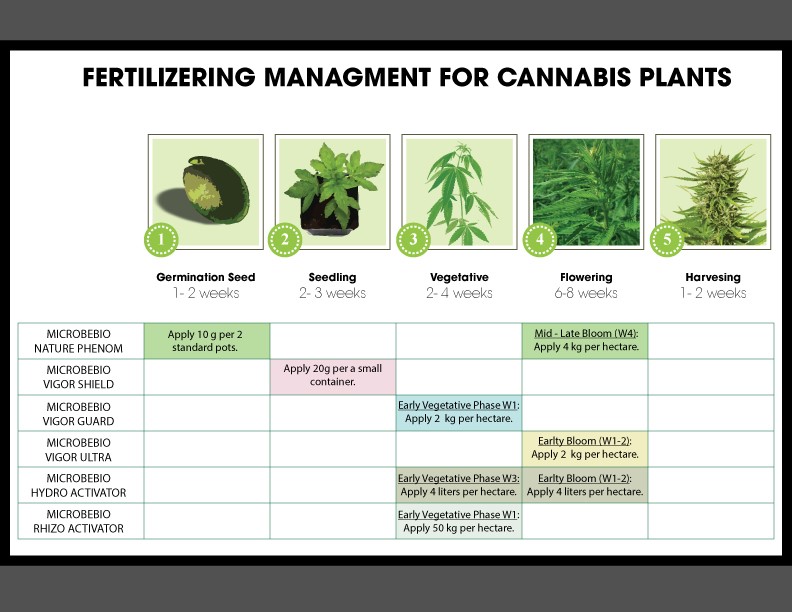
SOIL GERMINATION (est. 3 – 10 days)
Amongst the best ways to germinate cannabis seeds, this soil germination method is a low-risk, easy method that explains how to germinate your seeds in the soil. Germination can take 3 – 10 days, depending on environmental conditions and variety.
Tips: Never use direct soil from the backyard without treatment! It can contain pests and molds that will damage or destroy your seeds, seedlings, or plants.
Step 1: Collecting the cannabis seeds
For accelerating germination, the growers soak the seeds in a small container with lukewarm or distilled water, and place it in a dark and warm place for 12 – 24 hours, but no longer. The seeds should be drenched, so they can absorb the water thoroughly and activate significantly the germination process.
Tips: A quality cannabis seed indicates that it should be dry, hard, and brownish.
Soaking seeds also helps to loosen the shell as it becomes a little softer making it easier for the embryo to crack it open. When your seed sinks to the bottom it is ready to be planted, and sometimes the seed will pop out a small taproot. A seed can still be planted though if it does not sink.

Step 2: Preparing the soil
Prepare the standard pots or small containers with clean fresh soil. It is often easy to use small pots for this, and transport them to a larger later.
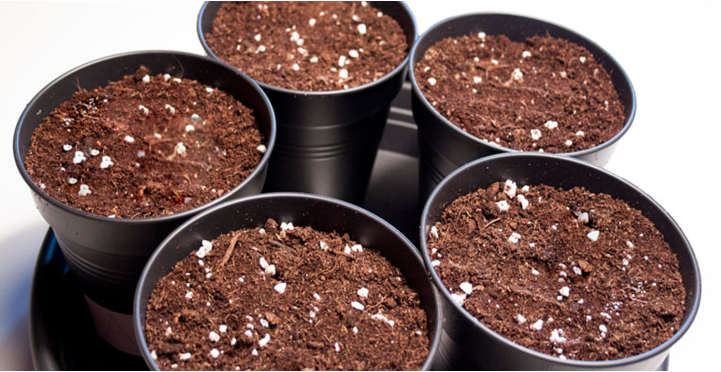
Recommended products:
- MicrobeBio® Nature Phenom:
The product comprises 100% organic nutrient-rich ingredients infused with value-added biologicals performed to be effective for providing the first coat to protect cannabis seeds in the new soil.
-
- Apply 10 g per 2 standard pots or a small container. Please follow the application on the label.
MICROBEBIO® NATURE PHENOM™
Introduction:
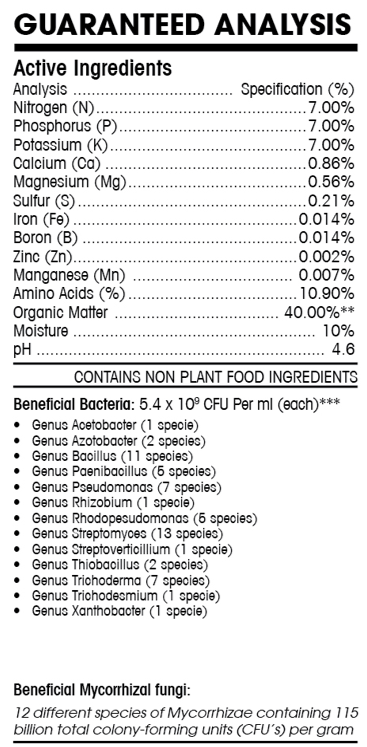
MicrobeBio® Nature Phenom™ is an all-organic biofertilizer using a proprietary biological finishing technique to deliver billions of beneficial microorganism specially selected for strong microbial adaptability with complete growth boost package derived from all-organic land plant materials, vital minerals mined from the Earth, ocean plants, crucial vitamins, natural plant hormones, essential sugars, vital amino acids, organic carbons, and proteins, that are essential to immediately initiate microbial colonization. Nature Phenom can enter the foliage and the root zone quickly to stimulate the photosynthesis process and boost the symbiotic cycle. Nature Phenom improves plant response, enhance natural plant defense mechanism, balance soil biological, and increase root systems which further improves the soil and reduces water use.
MicrobeBio® Nature Phenom™ provides the biology necessary to solubilize nutrients and fix nitrogen to meet the plant demands while improving stress/drought tolerance, improves seed germination, and increases root development. This product increases and stabilizes chlorophyll, which results in darker green leaves and increased sugar content in plants and aids in salt-resistance to optimize soil environment and plant growth. MicrobeBio® Nature Phenom™ will not burn and is completely safe for all life forms.
MicrobeBio® Nature Phenom™ probiotic function allows farmers to increase plant vigor, and thus imparts resistance to insect attacks helping to reduce operation cost and the need for chemical compounds and pesticides. This balanced and multi-functional product will greatly promote healthy soil while increasing crop yields and produce quality.
Benefits:
- Reduce adverse environmental impacts
- Heal and protect soil
- Boost root vitality, seed germination, crop yields, and drought resistance
- Unique molecules bind with plants and aid roots in receiving water and nutrients
- Dramatically increases yields due to optimized nutrition
- Enhances soil Cation Exchange Capacity (CEC) – a useful indicator of soil fertility that reflects the soil’s ability to supply three important plant nutrients: calcium, magnesium, and potassium
- Remineralizes soil that has been leached
- Aids sandy soils in retaining water and ionized nutrients when arid conditions prevail and hummus is lacking
- Organically chelated microelements in alkaline soils increase their availability for plants.
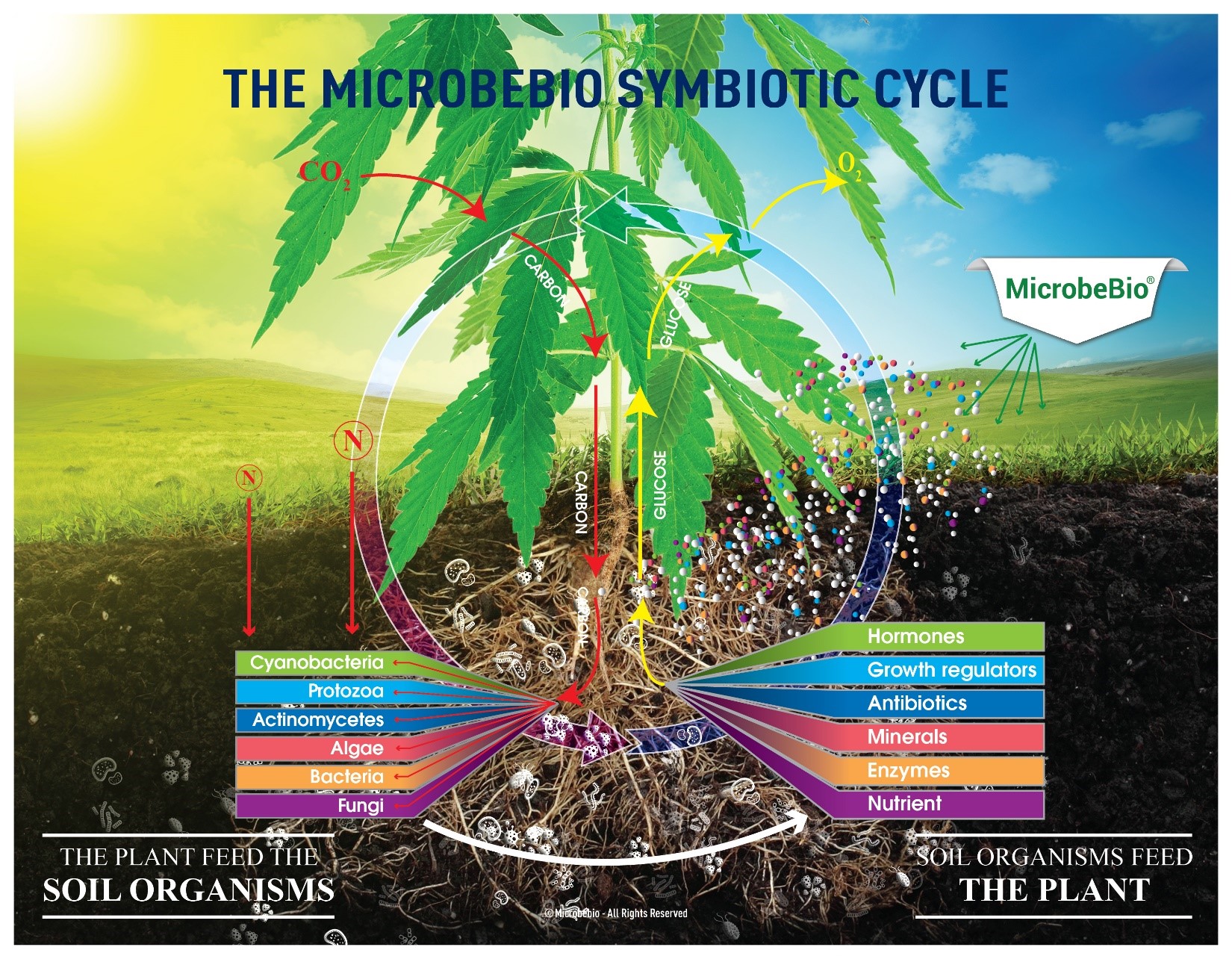
Nutrients from the product:
- Nitrogen is a component of many important organic compounds ranging from proteins to nucleic acids. The primary nutrient helps plant growing stronger and against plant pathogens.
- Phosphorus plays a central role in plants is with energy transfer and protein metabolism against harmful fungi.
- Potassium helps in osmotic and ionic regulation. Potassium functions as a cofactor or activator for many enzymes of carbohydrate and protein metabolism that prevent parasitize all of the reproductive stages of plant pathogenic nematodes.
- Calcium is involved in cell division and plays a major role in the maintenance of membrane integrity. This is a vital element that helps plants grow and develop.
- Magnesium is known as a component of chlorophyll and a cofactor for many enzymatic reactions. The process will create the best protection on the leaf surface where the harmful pests or fungi hard to latch on.
- Sulfur is somewhat like phosphorus in that it is involved in plant cell energy that assists plants to reduce pathogenic nematodes and fungi.
- Iron is an essential component of many hemes and nonheme iron enzymes and carries, including the cytochromes (respiratory electron carriers) and the ferredoxins. The latter are involved in key metabolic functions such as Nitrogen fixation, photosynthesis, and electron transfer.
- Zinc is known as an essential component of several dehydrogenases, and peptidases, including carbonic anhydrase, alcohol dehydrogenase, glutamic dehydrogenase, and malic dehydrogenase, among others.
- Manganese is involved in the oxygen-evolving system of photosynthesis and is a component of the enzymes arginase and phosphorus transferases that is the best support for plants against pathogenic fungi and pests’ eggs.
- Copper is a constituent of several important enzymes, including cytochrome, oxidize ascorbic acid oxidase, and laccase.
- Boron involves in carbohydrate metabolism and synthesis of cell wall components that help plants against most the attack from plant pathogens.
- Molybdenum is required for the normal assimilation of nitrogen in plants. An essential component of nitrate reductase as well as nitrogenase (N2 fixation enzyme)
- Chlorine is essential for photosynthesis and is an activator of enzymes involved in splitting water. It also functions in the osmoregulation of plants growing on saline soils.
- Using proprietary beneficial strains of microbes soil microbes to improve cannabis and hem growth:Our microbial products contain an unparalleled proprietary formula of 50+ strains of microorganisms. The most notable difference between our line of microbial products and that of other manufacturers is encompassed in the following three words: Bio-diversity, Endospores, and Equilibrium
- Bio-Diversity: This chain of 50+ strains of bio-diverse microorganisms are critical for promoting nutrient cycling in soil when applied to the root zone or as a foliar treatment. By contrast, mono-cultural strains (without diversity) are susceptible to environmental pathogens and more easily succumb to lysing, denaturation of their DNA, and death The bio-active potential of these microbial spores (vs. “live” microbes which live and die), ensure a longer duration of nutrient uptake by plants throughout all phases of the growth cycle
- Endospores: Our products contain viable bacteria, sporulated via fermentation. Rationale: Spores (vs. active cells) limit metabolism and catabolism, thereby increasing shelf life and minimizing excessive genetic mutation of bacterial cells, which can lead to mutant cells that do not perform the way they were intended. Converting our products into endospores ensures fidelity (long-term activity), significantly reduces genetic mutations, and stabilizes the quality of the product. By contrast, the quality of viable (“live”/active) cells in a container risks jug expansion or compression due to excess metabolism of CO2 production in the container. Endospores are the preferred form due to their preservation, fidelity, quality assurance of performance in the field, and high shelf life.
- Equilibrium: After many QA trials, we believe that heterogeneity of microbes promotes a prolonged duration of soil balance, resulting in season-long composting by the bacteria. Biodiversity and redundancy allow for accelerated organic mineralization in the soil nutrient release, perimeter protection against pathogens, improved soil tilth leading to better air and water channeling
GROWING CANNABIS AND HEMP:
Variant types of root and soil microorganisms play the single most important role in increasing the types and amounts of terpenes a plant is capable of producing. The product contains 50+ proprietary strains of microbes that have been isolated from flowering plants in their natural growing environments and selected for their ability to stimulate terpene and flavonoid production.
Benefits from microbes:
- Bio-available for the significantly increased absorption of plants.
- Support the cannabis/hemp to produce more oils, remain healthy, and carry higher nutrient densities.
- Boosting flavonoid (antioxidants)
- Increasing terpene production and creating an enhanced flavor and aroma profile.
- Nurturing plant probiotics known as the future of flavorful nutrient density.
All proprietary beneficial fungi to support root mass:
The product contains fungi supporting root extensions and yeast involving in secretory pathways of antibodies against diseases. Moreover, these fungi play a major role in the soil aggregation process and stimulate microbial activity that assists plant build and support the plant’s natural immune system to protect the plant from plant pathogens from fungi.
All proprietary beneficial vitamin sources:
The product contains the natural “bio-stimulant” for soil organisms and plants that support certain biological activators, to help plant against most plant pathogens from harmful nematodes, fungi, and pests.
All beneficial organic matter (more than 45% OM):
Presenting the best organic matter sources that belong to OMRI Standards.
Promote plant symbiotic cycle & photosynthesis by the proprietary plant probiotic formula:
- The product also contains a plant hormone component that helps:
- Promotes nutritional growth, increases chlorophyll content, and fiber weight in plants.
- Promotes development of leaf buds and flowers activates chlorophyll content and helps roots develop depth
- Highly efficient for propagation and micro-rooting
- Activate nitrogen absorption
- Complete the condensation of dry matter in the leaves where photosynthesis takes place
- Increased content of photosynthesis and assimilation of carbon dioxide.
- Increases seed donation and chlorophyll content of leaves.
Plant hormones work best when they are mixed with phytonutrients (highly difficult extraction technology) that act on a broad spectrum of plant cells to:
- Regulates absorption of ions into plant cells and reduces the heavy metal accumulation
- Improves the growth and perfection of photosynthesis through an antioxidant system when plants are exposed to cold climates
- Minimize cell damage caused by oxidation caused by high-temperature stress
- Helps to reduce water stress thanks to the oxidative system that reduces evapotranspiration, stomatal conductivity, and MDA content in seedlings.
- Reduces stress in the root zone by increasing the structure of the sugar-based carbon chain.
- Protects crops from herbicides, fungicides, and pesticides due to the increased ability of carbon dioxide to assimilate antioxidant enzymes.
Step 3: Watering the soil
Always keep the soil is wet, but do not soak it. It needs to be damp but not soaked, otherwise, you risk your seeds rotting. In most countries, normal tap water is clean enough to use. Do not add any additives to the water.
Tips: The ideal water is distilled water at the pH (6.5 – 7).
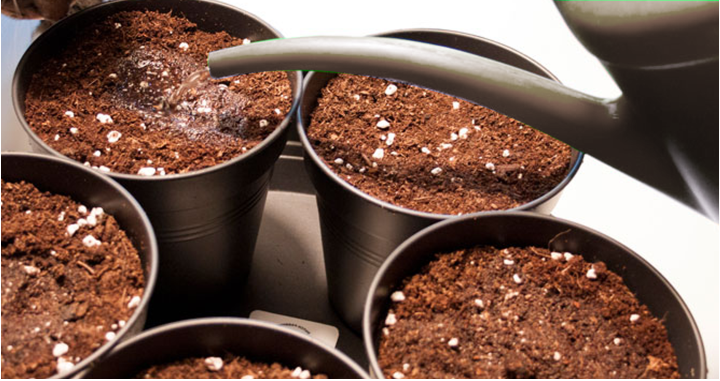
Step 4: Placing seeds inside the soil
Make a small dimple in the soil and place the seed 3 – 5mm deep inside the soil. Cover the seeds with soil and press the soil gently.
Tips: Don’t bury the seed too deep! When the seed is put too deep inside the soil, it will struggle to reach the surface and have a high risk of dying before it does.
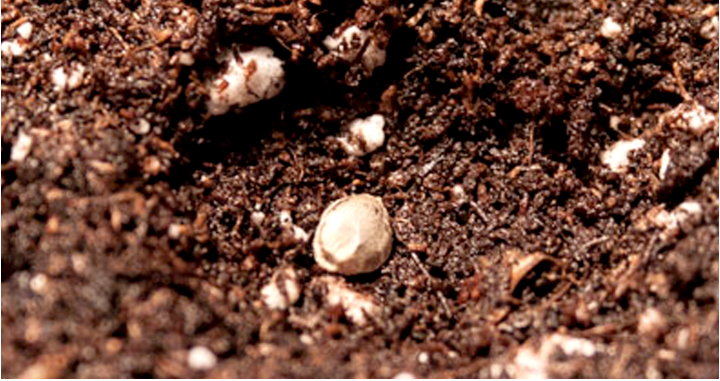
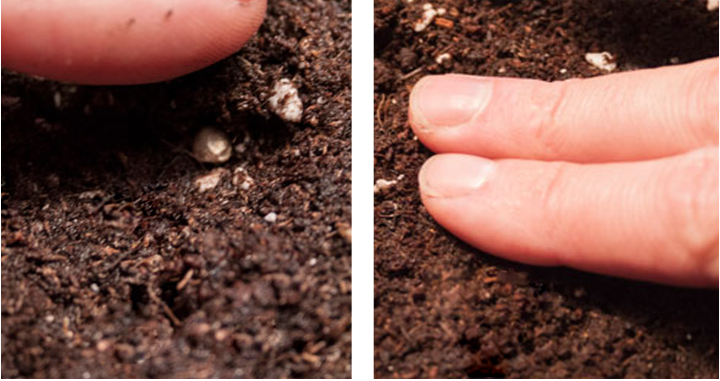
Step 5: Creating the ideal environment for the germination
Cover the pots or small containers with plastic wrap (with the small holes). The plastic wrap will act as a small greenhouse, keeping the inside of your pot warm and moist. Perfect for germination.
NOTE: when the growers prepare the germination in the greenhouse, do not need to wrap the plastic wrap. Please set up in a room with a stable temperature. 68 to 77 degrees Fahrenheit is ideal.
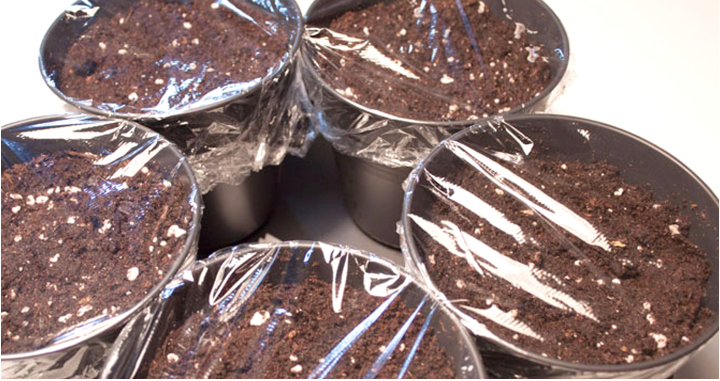
Step 6: Germinating
All you have to do now is wait. In our experience, it often takes about 5 – 7 days for the seedlings to show. But to calculate for differences in conditions and seeds, we say 3 – 10 days is a safe estimate. As soon as your seedling has sprouted (the first leaves reach the surface) you can remove the foil.
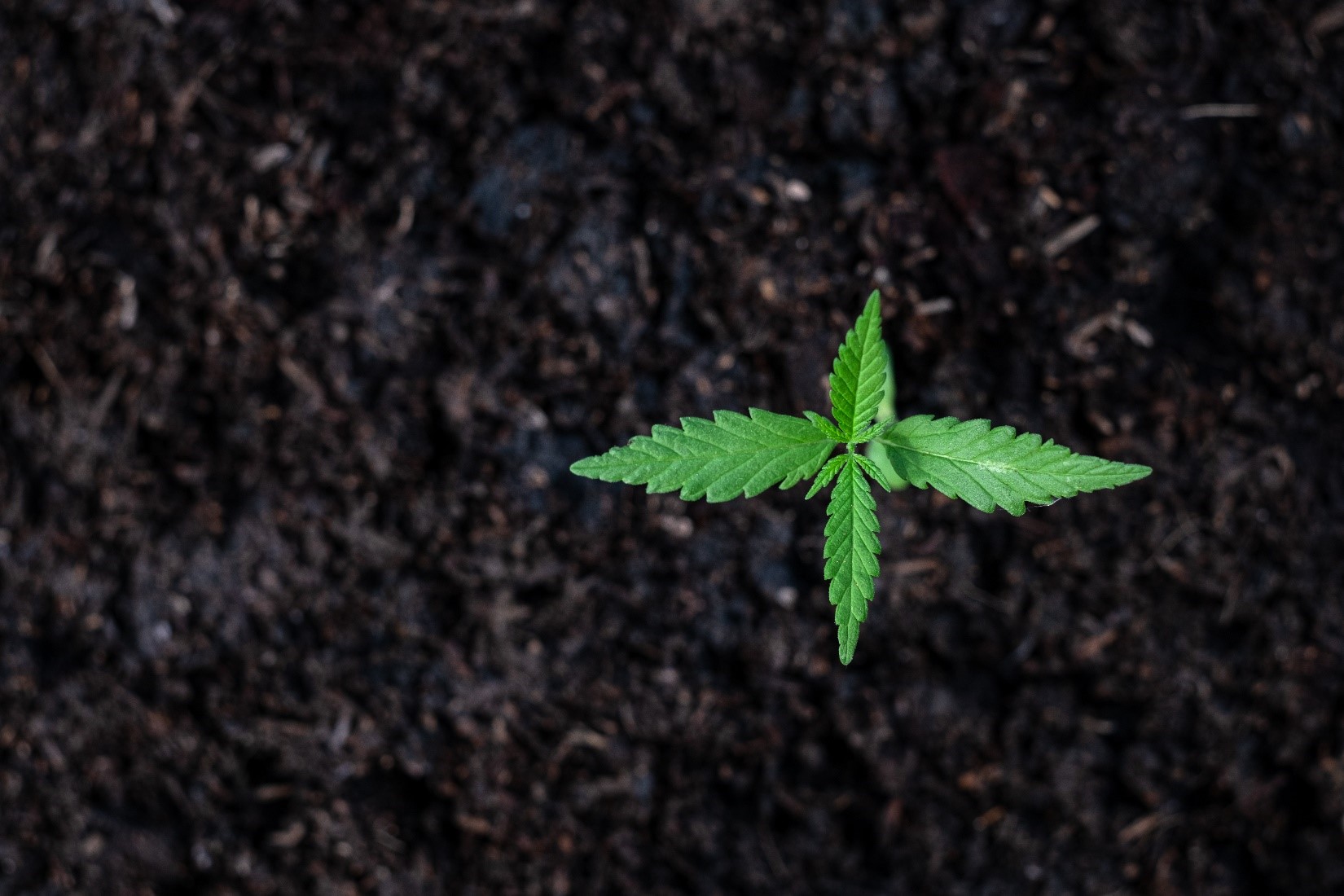
Note: The Sativa seeds usually take longer to germinate in comparison with Indica weed strains. When the first two leaves or taproot, the plant loses the seed husk and this is where the next stage begins.
Shortly, the seeds’ outer protective coating will crack and the root (a tiny white sprout) is pushed downward outside. Next leaves emerge out from within the shell as they search upward in search of light. After that, the seedling is formed.
HIGHLY RECOMMENDATION: Do not place this germination setup outside in direct sunlight, especially during summer. Day and night temperatures vary too much and sunlight will cause the temperature inside your soil to rise to a point where your seed will be damaged or killed by the heat.
SEEDLING PHASE (est. 2 – 4 weeks after the germination)
After 3 – 8 days of germination, the plant will be entered into its seedling phase of growth that lasts about a month.
- First, seeds have been germinated and sprouted a root, or a clone is placed in soil containers or small 2-inch pots, given nutrients, and lighting that are ready to start seedling.
- Fill the soil container or pots with loose, airy soil and poke a hole in the middle about a quarter-inch down using a pen or pencil.
- To transfer the seed, use a pair of tweezers to gently pick it up, then drop the seed in the hole with the taproot facing down. Lightly cover a germinated seed with soil.
- This stage requires the most care since the plant is susceptible to disease. The growers should be very careful about managing the water or fertilizer to treat the seedling. Watering the soil initially by using a spray bottle to provide moisture without over-saturating the soil. Over-watering and over-fertilizing may curb the growth because of suffocating and killing the delicate sprout.
Tips: Pay attention to the temperature and the moisture level of the soil to keep the seed happy, and within a week or so seedlings begin to grow from the soil. Suggesting use distilled water at the ideal pH (6.5 – 7).
- At this delicate stage, the vital demand for the plants is light. The plants need as much light as possible. Normally, the growers can provide the LED indoor lights that provide the full spectrum.
Recommended products:
- MicrobeBio® Vigor Shield:
The product contains the full beneficial nutrients and microorganisms that help cannabis prevent the nematodes through not only seedling but also the followed phases.
- Apply 20 g per 2 standard pots or a small container (note: apply at the transplanting time).
Please follow the application on the label.
2. Second, the plant will form its root system, stem, and couple of leaves
- Abundant light and water will allow the plants to develop stronger roots.
- The plants will start growing leaves. The shape of the leaf and the number of leaflets may vary depending on the kind of cannabis chosen. At this stage, the leaves usually have just one leaflet.
- Once the number leaflet becomes 5 – 7, the seedling stage is over.
Note: During the seedling phase time the plant is given 16 – 18 hours of light each day to ensure strong healthy growth.
The seedling time is from 2 – 4 weeks after seeds have germinated.
MICROBEBIO® VIGOR SHIELD™
Introduction:
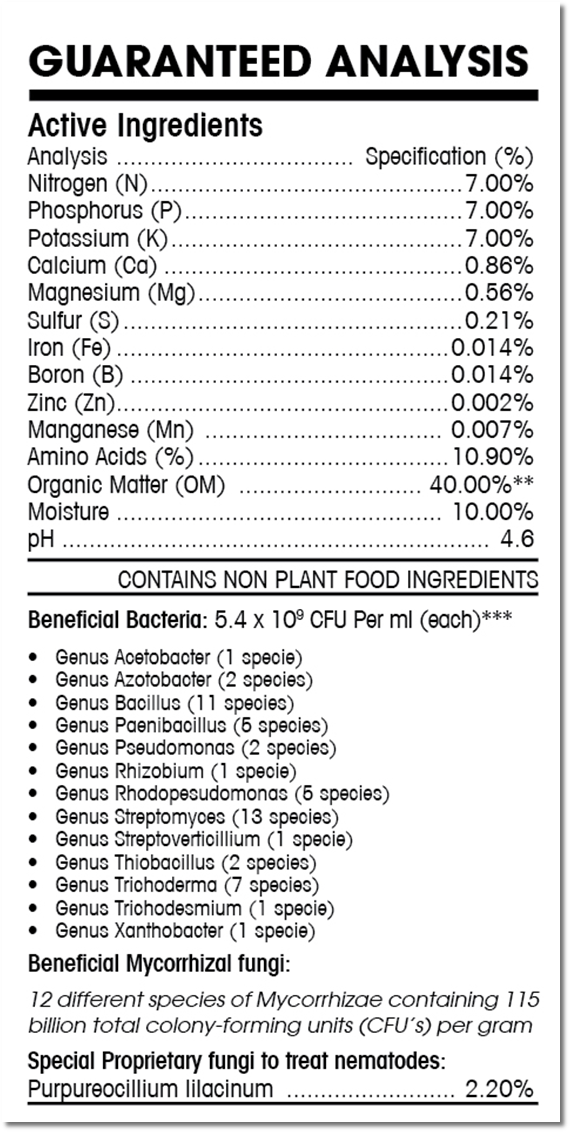
MicrobeBio® Vigor Shield™ consists of a synergistic consortium of naturally occurring soil microbes and organic matter designed to enhance virtually all crop types, soil conditions, and climates. It helps build and support the plant’s natural immune system to protect the plant from yield-robbing nematodes; thereby, promoting stronger, healthier roots and more robust yields.
MicrobeBio® Vigor Shield™ parasitizes all of the reproductive stages of plant pathogenic nematodes, specifically focused on the eggs and females. The under acidic pH conditions produces a toxin that attacks the nervous system of the nematodes and causes deformations and destruction of the ovaries, which reduces egg fertility. This reduces the nematode population, which greatly protects the plant’s root system. By adding this layer of protection, the roots can develop and grow freely into a healthy root system. While MicrobeBio® Vigor Shield™ rids the plant of pathogenic nematodes, it, in turn, promotes the reproduction and growth of beneficial nematodes, along with phosphorus and nitrogen-fixing microorganisms, allowing the plant to absorb more nutrients by the healthier grown root system.
MicrobeBio® Vigor Shield™ also allows the reproduction of beneficial nematodes and phosphorus and nitrogen-fixing microorganisms, thus allowing for the absorption of more nutrients by a healthy developed root system, stimulating significant plant growth. As a result, MicrobeBio® Vigor Shield™ improves drought tolerance, lower irrigation requirement, increases seed and fruit production, stimulates larger blooms, enhances nutrient uptake, root development, and chlorophyll synthesis
The product controls plant pathogenic nematodes, such as:
Ditylenchus sp.; Helicotylenchus sp.; Meloidogyne sp.; Radopholus sp.; Pratylenchus sp.; Rotylenchulus sp.; Tylenchus sp., and Xiphinema sp.
BENEFITS:
- Ability to dissolve insoluble minerals
- Maximize photosynthesis
- Promote and increase crop yield
- Benefits the overall plant vigor
- Soil environment improves for aerobic biological growth and diversity
- Heighten water-use efficiency
- Builds nutrient availability at all soil pH levels
- Inhibition of Plant Pathogens including pathogenic nematodes
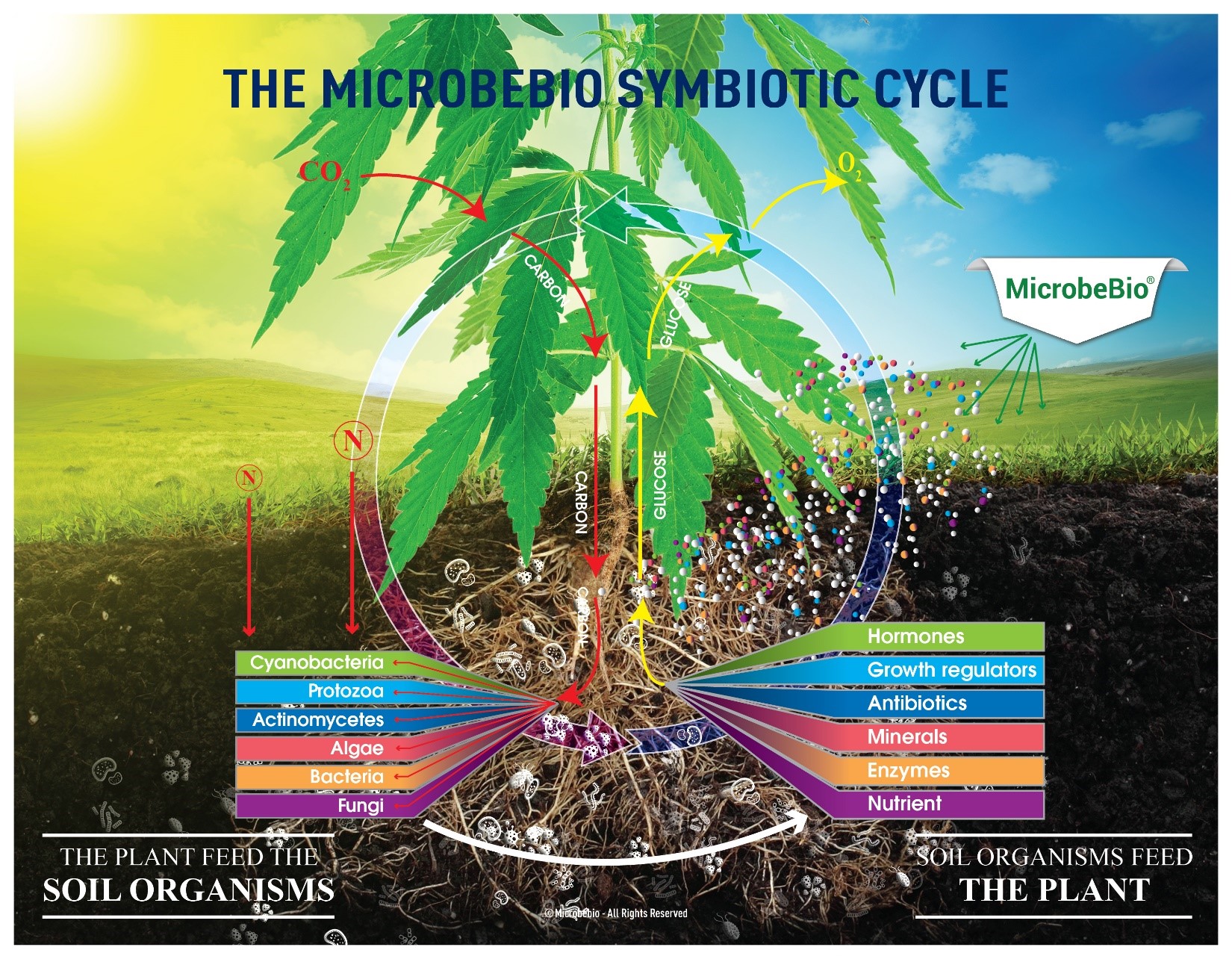
Nutrients from the product:
- Nitrogen is a component of many important organic compounds ranging from proteins to nucleic acids. The primary nutrient helps plant growing stronger and against plant pathogens.
- Phosphorus plays a central role in plants with energy transfer and protein metabolism against harmful fungi.
- Potassium helps in osmotic and ionic regulation. Potassium functions as a cofactor or activator for many enzymes of carbohydrate and protein metabolism that prevent parasitize all of the reproductive stages of plant pathogenic nematodes.
- Calcium is involved in cell division and plays a major role in the maintenance of membrane integrity. This is a vital element that helps plants grow and develop.
- Magnesium is known as a component of chlorophyll and a cofactor for many enzymatic reactions. The process will create the best protection on the leaf surface where the harmful pests or fungi hard to latch on.
- Sulfur is somewhat like phosphorus in that it is involved in plant cell energy that assists plants to reduce pathogenic nematodes and fungi.
- Iron is an essential component of many hemes and nonheme iron enzymes and carries, including the cytochromes (respiratory electron carriers) and the ferredoxins. The latter are involved in key metabolic functions such as Nitrogen fixation, photosynthesis, and electron transfer.
- Zinc is known as an essential component of several dehydrogenases, and peptidases, including carbonic anhydrase, alcohol dehydrogenase, glutamic dehydrogenase, and malic dehydrogenase, among others.
- Manganese is involved in the oxygen-evolving system of photosynthesis and is a component of the enzymes arginase and phosphorus transferases that is the best support for plants against pathogenic fungi and pests’ eggs.
- Copper is a constituent of several important enzymes, including cytochrome, oxidize ascorbic acid oxidase, and laccase.
- Boron involves in carbohydrate metabolism and synthesis of cell wall components that help plants against most the attack from plant pathogens.
- Molybdenum is required for the normal assimilation of nitrogen in plants. An essential component of nitrate reductase as well as nitrogenase (N2 fixation enzyme)
- Chlorine is essential for photosynthesis and is an activator of enzymes involved in splitting water. It also functions in the osmoregulation of plants growing on saline soils.
Using proprietary beneficial strains of microbes soil microbes to improve cannabis and hem growth:
Our microbial products contain an unparalleled proprietary formula of 50+ strains of microorganisms. The most notable difference between our line of microbial products and that of other manufacturers is encompassed in the following three words: Bio-diversity, Endospores, and Equilibrium
- Bio-Diversity: This chain of 50+ strains of bio-diverse microorganisms are critical for promoting nutrient cycling in soil when applied to the root zone or as a foliar treatment. By contrast, mono-cultural strains (without diversity) are susceptible to environmental pathogens and more easily succumb to lysing, denaturation of their DNA, and death The bio-active potential of these microbial spores (vs. “live” microbes which live and die), ensure a longer duration of nutrient uptake by plants throughout all phases of the growth cycle
- Endospores: Our products contain viable bacteria, sporulated via fermentation. Rationale: Spores (vs. active cells) limit metabolism and catabolism, thereby increasing shelf life and minimizing excessive genetic mutation of bacterial cells, which can lead to mutant cells that do not perform the way they were intended. Converting our products into endospores ensures fidelity (long-term activity), significantly reduces genetic mutations, and stabilizes the quality of the product. By contrast, the quality of viable (“live”/active) cells in a container risks jug expansion or compression due to excess metabolism of CO2 production in the container. Endospores are the preferred form due to their preservation, fidelity, quality assurance of performance in the field, and high shelf life.
- Equilibrium: After many QA trials, we believe that heterogeneity of microbes promotes a prolonged duration of soil balance, resulting in season-long composting by the bacteria. Biodiversity and redundancy allows for accelerated organic mineralization in the soil nutrient release, perimeter protection against pathogens, improved soil tilth leading to better air and water channeling
GROWING CANNABIS AND HEMP:
Variant types of root and soil microorganisms play the single most important role in increasing the types and amounts of terpenes a plant is capable of producing. The product not only contains 50+ proprietary strains of microbes that have been isolated from flowering plants in their natural growing environments and selected for their ability to stimulate terpenes and flavonoid production but also mingles with proprietary strains of microbes protecting cannabis and hemp from the nematodes.
Benefits from microbes:
- Bio-available for the significantly increased absorption of plants.
- Support the cannabis/hemp to produce more oils, remain healthy, and carry higher nutrient densities.
- Boosting flavonoid (antioxidants)
- Increasing terpene production and creating an enhanced flavor and aroma profile.
- Nurturing plant probiotics known as the future of flavorful nutrient density.
All proprietary beneficial fungi to support root mass:
The product contains fungi supporting root extensions and yeast involving in secretory pathways of antibodies against diseases. Moreover, these fungi play a major role in the soil aggregation process and stimulate microbial activity that assists plant build and support the plant’s natural immune system to protect the plant from plant pathogens from fungi.
All proprietary beneficial vitamin sources:
The product contains the natural “bio-stimulant” for soil organisms and plants that support certain biological activators, to help plant against most plant pathogens from harmful nematodes, fungi, and pests.
All beneficial organic matter (more than 45% OM):
Presenting the best organic matter sources that belong to OMRI Standards.
Promote plant symbiotic cycle & photosynthesis by the proprietary plant probiotic formula:
- The product also contains a plant hormone component that helps:
- Promotes nutritional growth, increases chlorophyll content, and fiber weight in plants.
- Promotes development of leaf buds and flowers activates chlorophyll content and helps roots develop depth
- Highly efficient for propagation and micro-rooting
- Activate nitrogen absorption
- Complete the condensation of dry matter in the leaves where photosynthesis takes place
- Increased content of photosynthesis and assimilation of carbon dioxide.
- Increases seed donation and chlorophyll content of leaves.
Plant hormones work best when they are mixed with phytonutrients (highly difficult extraction technology) that act on a broad spectrum of plant cells to:
- Regulates absorption of ions into plant cells and reduces the heavy metal accumulation
- Improves the growth and perfection of photosynthesis through an antioxidant system when plants are exposed to cold climates
- Minimize cell damage caused by oxidation caused by high-temperature stress
- Helps to reduce water stress thanks to the oxidative system that reduces evapotranspiration, stomatal conductivity, and MDA content in seedlings.
- Reduces stress in the root zone by increasing the structure of the sugar-based carbon chain.
- Protects crops from herbicides, fungicides, and pesticides due to the increased ability of carbon dioxide to assimilate antioxidant enzymes.
VEGETATIVE PHASE (est. 2 – 4 weeks after the seedling phase)
During the vegetation stage, the growth accelerates. Your plant can grow as much as 5 inches in just one day. You need to supply the right nutrients to the plants at this time for them to start growing buds. The growers start to transplant the small plants into the soil.
During this early phase, if there is a need to feed, give the higher ratio of N and only modest amounts of P and K:
- Nitrogen is crucial at this point as it helps provide chlorophyll and protein.
- Phosphorus plays a role in energy transfer, photosynthesis, and the transformation of starches and sugars
- Potassium contributes to plant growth, metabolic functions, stress tolerance, root growth, and root system structure
The cannabis plants still need more than just three nutrients to survive and thrive. It also counts on secondary nutrients like calcium, magnesium, and sulfur to play vital roles in plant growth:
- Calcium is important for cell wall development can help reduce soil salinity, and improves water penetration when used as a soil amendment.
- Magnesium plays a key role in photosynthesis and carbohydrate metabolism, and also helps with the stabilization of plant cell walls.
- Sulfur is necessary for the formation of chlorophyll and the production of proteins, amino acids, enzymes and vitamins, and protects plants against disease.
These include Boron, Chlorine, Copper, Iron, Manganese, Molybdenum, and Zinc. While these are not the main nutrients plants use for food, they still play very important roles in various aspects of cannabis plants’ health.
Normally, the essential macronutrients are for cannabis in the vegetative phase:
Early vegetative phase ( week 1 after the germination):
Recommended products:
- MicrobeBio® Vigor Guard:
The product comprises 100% organic nutrient-rich ingredients infused with value-added biologicals performed to be effective cannabis plants against pathogens from fungi.
- Apply 2 kg per hectare. Please follow the application on the label.
- Micorbebio® Rhizo Activator:
The product presents the slow-release nutrients that will provide nutrients for cannabis plants throughout a growing season.
Spread 50 kg per hectare (at the root area). Please follow the application on the label.
Middle vegetative phase ( week 2 to week 3 after the germination):
Recommended products:
- Microbebio® Hydro Activator:
The product contains the best source of minerals from the ocean that provide the most nutrients for cannabis plant growth.
Apply 4 liters per hectare. Please follow the application on the label.
- Require the minimum macronutrients ratio at 10:5:7
- The young plants have survived germination and the seedling stage has now come to an end. The two to three sets of leaves that have unfolded during days 4 to 5 have been growing steadily and expanding their leaf surface under good light conditions.
Late vegetable phase ( week 4 after the germination):
- Require the minimum macronutrients ratio at 7:7:7
- Many of the plants will have 4-5 nodes under a photoperiod of 18 hours of light, 6 hours of dark. Ideally, the young cannabis plant only needs 16 hours of lighting during the vegetative stage. Maintain temperatures of 69 -75 °F.
- Visually observe plants at this early stage for any signs of stress and nutrient deficiencies. A healthy plant remains green through early growth. The onset of early nutrient stress is often caused by pH levels that are falling outside the range that cannabis prefers.
Water and sunlight management:
- The water intake of the plants also increases at this stage.
- The light remains a vital component for growth. You need to have the best lights for all cycles of cannabis growth. Most grow lights have a vegetation model that is optimized for this stage of the cannabis plants.
The duration of the vegetation stage varies greatly from one variety of cannabis to another. However, if everything is done right and the plant is growing in a healthy way it should gradually move to the next stage of growth within 2 – 3 weeks.
Fungal management:
| Fungus gnat | Alternaria | Fusarium | Mildew |
| Pythium | Gray Mold | Botrytis | Root Rot |
MICROBEBIO® VIGOR GUARD™
Introduction:
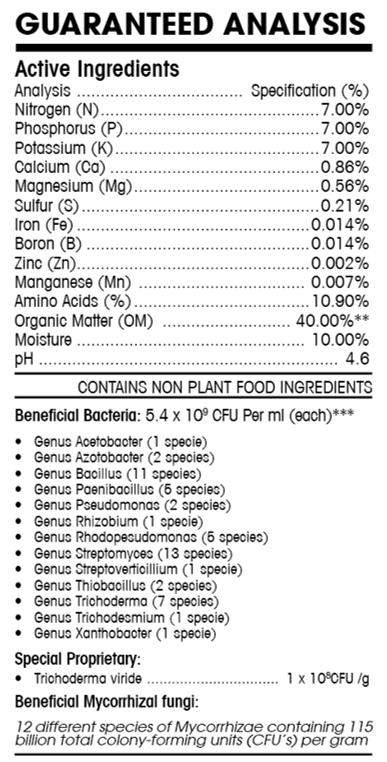
MicrobeBio® Vigor Guard™ comprises a synergistic consortium of naturally occurring probiotic soil microbes, macro/micronutrients, and organic matter designed to enhance virtually all crop types, soil conditions, and climates. It contains a natural rhizosphere bacterium that quickly populates the soil, forming protective colonies around delicate root hairs and on the leaf surface. Each gram-positive bacterium in this product, which survives in extreme environmental conditions including heat and drought, salinity, and extreme pH making it a durable, reliable, and effective control and suppression of soil-borne and foliar fungal and bacterial diseases.
The product better protects plants against pathogenic plant fungi such as
Fusarium oxysporum f.sp. lycopersici; Fusarium oxysporum f.sp. cubense; Fusarium oxysporum f.sp. dianthi; Rhizoctonia solani; Sclerotium rolfsii; Sclerotinia sclerotiorum; Pythium ultimum; Phytophthora infestans; and P. nicotiana
BENEFITS:
- Ability to dissolve insoluble minerals
- Maximize photosynthesis
- Promote and increase crop yield
- Benefits the overall plant vigor
- Soil environment improves for aerobic biological growth and diversity
- Heighten water-use efficiency
- Builds nutrient availability at all soil pH levels
- Inhibition of Plant Pathogens including pathogenic fungi
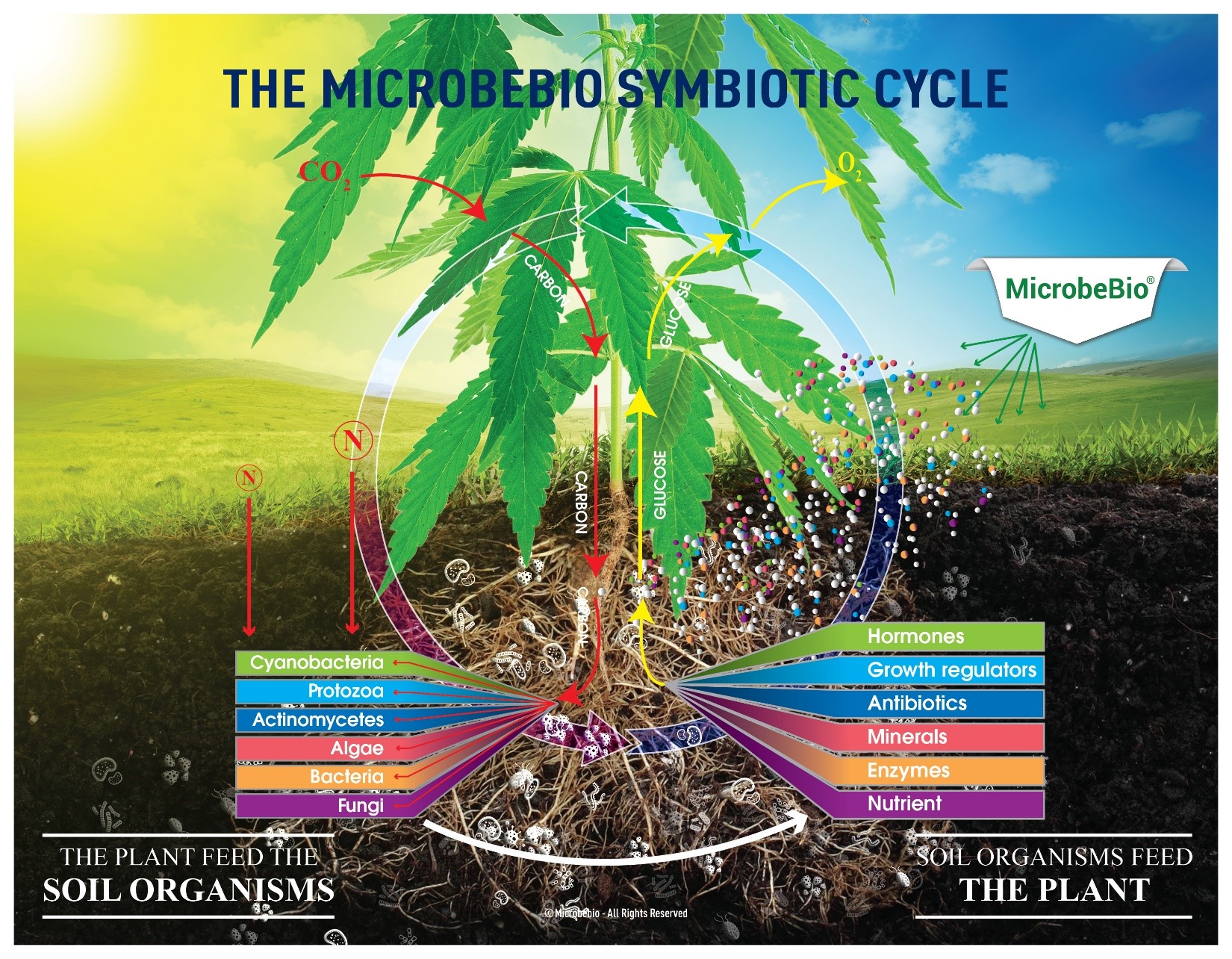
Using proprietary beneficial strains of microbes soil microbes to improve cannabis and hem growth:
- Nitrogen is a component of many important organic compounds ranging from proteins to nucleic acids. The primary nutrient helps plant growing stronger and against plant pathogens.
- Phosphorus plays a central role in plants with energy transfer and protein metabolism against harmful fungi.
- Potassium helps in osmotic and ionic regulation. Potassium functions as a cofactor or activator for many enzymes of carbohydrate and protein metabolism that prevent parasitize all of the reproductive stages of plant pathogenic nematodes.
- Calcium is involved in cell division and plays a major role in the maintenance of membrane integrity. This is a vital element that helps plants grow and develop.
- Magnesium is known as a component of chlorophyll and a cofactor for many enzymatic reactions. The process will create the best protection on the leaf surface where the harmful pests or fungi hard to latch on.
- Sulfur is somewhat like phosphorus in that it is involved in plant cell energy that assists plants to reduce pathogenic nematodes and fungi.
- Iron is an essential component of many hemes and nonheme iron enzymes and carries, including the cytochromes (respiratory electron carriers) and the ferredoxins. The latter are involved in key metabolic functions such as Nitrogen fixation, photosynthesis, and electron transfer.
- Zinc is known as an essential component of several dehydrogenases, and peptidases, including carbonic anhydrase, alcohol dehydrogenase, glutamic dehydrogenase, and malic dehydrogenase, among others.
- Manganese is involved in the oxygen-evolving system of photosynthesis and is a component of the enzymes arginase and phosphorus transferases that is the best support for plants against pathogenic fungi and pests’ eggs.
- Copper is a constituent of several important enzymes, including cytochrome, oxidize ascorbic acid oxidase, and laccase.
- Boron involves in carbohydrate metabolism and synthesis of cell wall components that help plants against most the attack from plant pathogens.
- Molybdenum is required for the normal assimilation of nitrogen in plants. An essential component of nitrate reductase as well as nitrogenase (N2 fixation enzyme)
- Chlorine is essential for photosynthesis and is an activator of enzymes involved in splitting water. It also functions in the osmoregulation of plants growing on saline soils.
All proprietary beneficial microbes:
Our microbial products contain an unparalleled proprietary formula of 50+ strains of microorganisms. The most notable difference between our line of microbial products and that of other manufacturers is encompassed in the following three words: Bio-diversity, Endospores, and Equilibrium
- Bio-Diversity: This chain of 50+ strains of bio-diverse microorganisms are critical for promoting nutrient cycling in soil when applied to the root zone or as a foliar treatment. By contrast, mono-cultural strains (without diversity) are susceptible to environmental pathogens and more easily succumb to lysing, denaturation of their DNA, and death The bio-active potential of these microbial spores (vs. “live” microbes which live and die), ensure a longer duration of nutrient uptake by plants throughout all phases of the growth cycle
- Endospores: Our products contain viable bacteria, sporulated via fermentation. Rationale: Spores (vs. active cells) limit metabolism and catabolism, thereby increasing shelf life and minimizing excessive genetic mutation of bacterial cells, which can lead to mutant cells that do not perform the way they were intended. Converting our products into endospores ensures fidelity (long-term activity), significantly reduces genetic mutations, and stabilizes the quality of the product. By contrast, the quality of viable (“live”/active) cells in a container risks jug expansion or compression due to excess metabolism of CO2 production in the container. Endospores are the preferred form due to their preservation, fidelity, quality assurance of performance in the field, and high shelf life.
- Equilibrium: After many QA trials, we believe that heterogeneity of microbes promotes a prolonged duration of soil balance, resulting in season-long composting by the bacteria. Biodiversity and redundancy allow for accelerated organic mineralization in the soil nutrient release, perimeter protection against pathogens, improved soil tilth leading to better air and water channeling
GROWING CANNABIS AND HEMP:
Variant types of root and soil microorganisms play the single most important role in increasing the types and amounts of terpenes a plant is capable of producing. The product not only contains 50+ proprietary strains of microbes that have been isolated from flowering plants in their natural growing environments and selected for their ability to stimulate terpenes and flavonoid production but also mingles with proprietary strains of microbes protecting cannabis and hemp from the pathogenic fungi.
Benefits from microbes:
- Bio-available for the significantly increased absorption of plants.
- Support the cannabis/hemp to produce more oils, remain healthy, and carry higher nutrient densities.
- Boosting flavonoid (antioxidants)
- Increasing terpene production and creating an enhanced flavor and aroma profile.
- Nurturing plant probiotics known as the future of flavorful nutrient density.
All proprietary beneficial fungi to support root mass:
The product contains fungi supporting root extensions and yeast involving in secretory pathways of antibodies against diseases. Moreover, these fungi play a major role in the soil aggregation process and stimulate microbial activity that assists plant build and support the plant’s natural immune system to protect the plant from plant pathogens from fungi.
All proprietary beneficial vitamin sources:
The product contains the natural “bio-stimulant” for soil organisms and plants that support certain biological activators, to help plant against most plant pathogens from harmful nematodes, fungi, and pests.
All beneficial organic matter (more than 45% OM):
Presenting the best organic matter sources that belong to OMRI Standards.
Promote plant symbiotic cycle & photosynthesis by the proprietary plant probiotic formula:
- The product also contains a plant hormone component that helps:
- Promotes nutritional growth, increases chlorophyll content, and fiber weight in plants.
- Promotes development of leaf buds and flowers activates chlorophyll content and helps roots develop depth
- Highly efficient for propagation and micro-rooting
- Activate nitrogen absorption
- Complete the condensation of dry matter in the leaves where photosynthesis takes place
- Increased content of photosynthesis and assimilation of carbon dioxide.
- Increases seed donation and chlorophyll content of leaves.
Plant hormones work best when they are mixed with phytonutrients (highly difficult extraction technology) that act on a broad spectrum of plant cells to:
- Regulates absorption of ions into plant cells and reduces the heavy metal accumulation
- Improves the growth and perfection of photosynthesis through an antioxidant system when plants are exposed to cold climates
- Minimize cell damage caused by oxidation caused by high-temperature stress
- Helps to reduce water stress thanks to the oxidative system that reduces evapotranspiration, stomatal conductivity, and MDA content in seedlings.
- Reduces stress in the root zone by increasing the structure of the sugar-based carbon chain.
- Protects crops from herbicides, fungicides, and pesticides due to the increased ability of carbon dioxide to assimilate antioxidant enzymes.
MICROBEBIO® HYDRO ACTIVATOR™
Introduction:
MicrobeBio® Hydro Activator™ is an all-organic liquid fertilizer that was designed to promote the fruiting period and dramatically increase the Brix levels of productivity. MicrobeBio® Hydro Activator™ promotes earlier flowering and leads to larger blooms and fruit. Using MicrobeBio® Hydro Activator™ will greatly increase the quality of the product and slow the aging process. MicrobeBio® Hydro Activator™ is created with more than forty mineral elements, organic proteins, and essential amino acids that are made available for plants to uptake during the different stages of growth. It is packed full of the essential Macro and Micronutrients that are crucial for superior plant growth and development. You will see a major improvement in product quality when using MicrobeBio hydro activator – produce will look fresher, have healthier greener leaves, and will be significantly tastier, and have an increase in storage time.
Benefits:
- Immediately delivers primary nutrients (NPK) and renders them readily accessible for plant roots
- Furnishes a premium-selected sequential chain of sustainable, life-giving microbes for continuing soil and plant health
- Stimulates significant bio-mass (root) growth which is essential for plant health and growth
- Enhances plant BRIX levels (sugars) to enrich the bio-available food source for soil microbes
- Remediates salinity and heavy metal contamination in soils
- Improves water retention (by expanding the root system) and increases drought tolerance
- Balances pH in acid or alkaline conditions for optimal nutrient uptake
- Maintains a C:N Ratio (Carbon & Nitrogen) by activating microbes to release nutrients such as nitrogen, phosphorus, and zinc to crops
- Boosts chlorophyll content in leaves to invigorate the photosynthesis process
- Acts as a powerful prophylactic by preventing harmful Rhizoctonia and fusarium spores from germinating.
- Is comprised of 100% eco-friendly elements, which are non-toxic and are safe to use around children, adults, pets, and livestock.
MICROBEBIO® RHIZO ACTIVATOR™
Introduction:
MicrobeBio® Rhizo Activator™ is an all-natural and organic granular slow-release fertilizer enhanced with mycorrhizae and beneficial microbes that were designed to primarily stimulate plant root growth. Rhizo Activator is packed full of essential beneficial microbes, Macro, and Micronutrients that are crucial to superior plant growth, and delivers these nutrients in a form that is consistently available for the plant’s immediate use. Rhizo Activator contains primary and secondary nutrients, along with organic matter with available nitrogen sources, as well as bio-stimulants and advanced biological humic and fulvic acids. This combination of organic and mineral elements establishes the fundamental food sources needed in order to stimulate the colonization of beneficial soil microbes, regardless of the crop or condition of the soil. Once MicrobeBio Rhizo Activator is applied to the soil, millions upon millions of these beneficial bacteria and microbes begin to make their way to the plant root zone to develop and form a fully functional extended network of fine filaments that covers over seven hundred times more soil area. This establishes and forms a symbiotic relationship, colonizing the plant’s root zone and providing it with a greater increase in water and nutrient absorption efficiency. The increase in the plant’s root mass allows for the plant to reach more of the beneficial nutrients and water that would have otherwise been unavailable for use without having used Rhizo Activator. The plant will also show improved drought tolerance and have much lower irrigation requirements. Rhizo Activator will strengthen the entire plant’s root system, allowing the plant to grow stronger, bigger, and more vigorous. This leads to generating a higher yield and better protection against pests, disease, and unfavorable environmental conditions. Rhizo Activator greatly enhances bio-geochemical processes such as the Carbon Cycle, Nitrogen Cycle, Mineralization, as well as Decomposition. It gives the soil the ability to better hold, convert, stabilize and increase the nitrogen. Rhizo Activator ensures the absorption of the available bio-stimulants and helps to fight the nutrient deterioration in nearby sources of water. This is because our product was designed to break down slowly in conjunction with the response produced by the plant, rather than merely dissolving in water. This results in a major reduction of groundwater leeching and excess runoff of nutrients. MicrobeBio Rhizo Activator is an all-around environmentally friendly agricultural product that majorly minimizes nutrient pollution.
Benefits:
- Improved root depth and density.
- Stimulate biological activity by increasing microbial colony.
- Stimulate plant growth and increased yield
- Deliver primary nutrient source of food for plants
- Remediate salinity and heavy metal contamination in soils
- Regulate pH in acid or alkaline conditions
- Increases BRIX levels
- Increase organic matter and Carbon source
- Increase Chlorophyll Content
- Enhance natural defenses
- Improve water retention
- Improve soil structure
FLOWERING PHASE (est. 8 – 11 weeks after the vegetable phase)
Flowering cannabis plants need less nitrogen and more potassium to promote the growth of big, resinous flowers.
Normally, the essential macronutrients are for cannabis in the flowering phase:
- Early flowering phase (est. week 1 after the vegetative phase)
Recommended products:
- MicrobeBio® Vigor Ultra:
The product contains 100% organic nutrient-rich ingredients infused with value-added biologicals performed to be effective for cannabis plants to prevent pathogenic pests and insects.
- Apply 2 kg per hectare. Please follow the application on the label.
- Micorbebio® Hydro Activator:
The product contains the best source of minerals from the ocean that provide the most nutrients for cannabis leaves and flowers.
Apply 4 liters per hectare. Please follow the application on the label.
- Require the minimum macronutrients ratio at 5:7:10
- During the first two weeks of flowering, most growers feed their flowering plants. In general, the growers’ common practices to keep dialing up the nutrients on all fronts, always keeping potassium concentrations higher than the rest.
Pests and Insects Management
| Caterpillars | Whitefly | Mealybug |
| Red spider mite | Aphids | Thrips |
MICROBEBIO® VIGOR ULTRA™
Introduction:
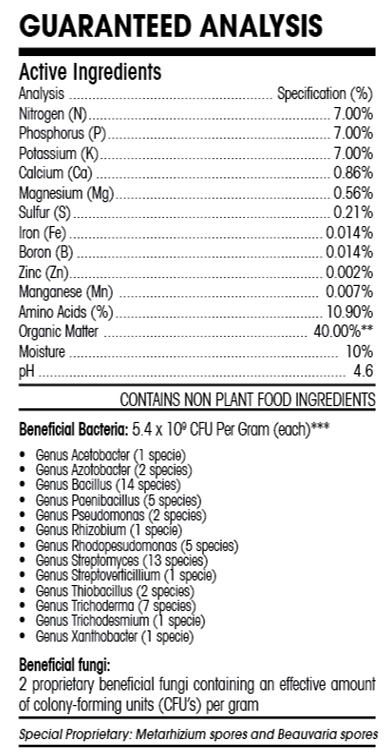
MicrobeBio® Vigor Ultra™ consists of a synergistic consortium of naturally occurring probiotic soil microbes, essential macro/micronutrients, and organic matter designed to enhance virtually all crop types, soil conditions, and climates. MicrobeBio®
Vigor Ultra™ also enhances natural plant defense mechanisms against certain soft-tissue pests reducing the need for chemical pesticides.
This product is created to boost plant immunity around the phyllospheric zone to defend against physical and biological environmental stresses while increasing crop yield and nutrient uptake. MicrobeBio® Vigor Ultra™ provides increased water and nutrient absorption capabilities by colonizing the root zone, which then forms a symbiotic relationship with the plant. The benefits are reflected by lower irrigation requirements, improved drought tolerance, enhanced transplant survivability, increased seed and fruit production, overall health and appearance, and more vigorous fast-growing plants nitrogen boost for superior plant growth. MicrobeBio® Vigor Ultra™ assists in building and supporting the plant’s natural immune system and its capability to withstand pests, disease, and extreme conditions.
MicrobeBio® Vigor Ultra™ contains 100% organic nutrient-rich ingredients infused with value-added biologicals shown to be effective for the prevention and suppression outbreak of soft-bodied insects such as Alfalfa Weevil, Aphids, Apple Cleaving Moth, Fall Army Worms, Bark Beetles, Bean Leaf Beetle, Best Leafhopper, Beetles, Black Vine Weevil, Boll Weevil, Cabbage Looper, Cabbage Worm, Cane Borer, Caterpillars, Cereal Leaf Beetle, Chinch Bugs, Coffee Borer Beetle, Codling Moth, Colorado Potato Beetle, Corn Borer, Cucumber Beetle, Douglas Fir Tussock Moth, Emerald Ash Borer, Fire Ants Flies, Fungal Gnats, Grasshoppers, Greenhouse Whitefly, Invasive Silkworms, Japanese Beetle, Lygus Bugs, Mealybugs, Mexican Bean Beetle, Mites, Psyllids, Red Palm Weevil, Shore Flies, Stem Borers, Stink Bugs, Strawberry Root Weevil, Termites, Thrips, Whiteflies, White Grubs
BENEFITS:
- Loosens and aerates the compact soil
- Increases drought, stress & Salt Tolerance
- Increase rate of photosynthesis
- Improves the effectiveness of nutrient absorption and uptake
- Promote higher yield
- Improves overall plant vigor
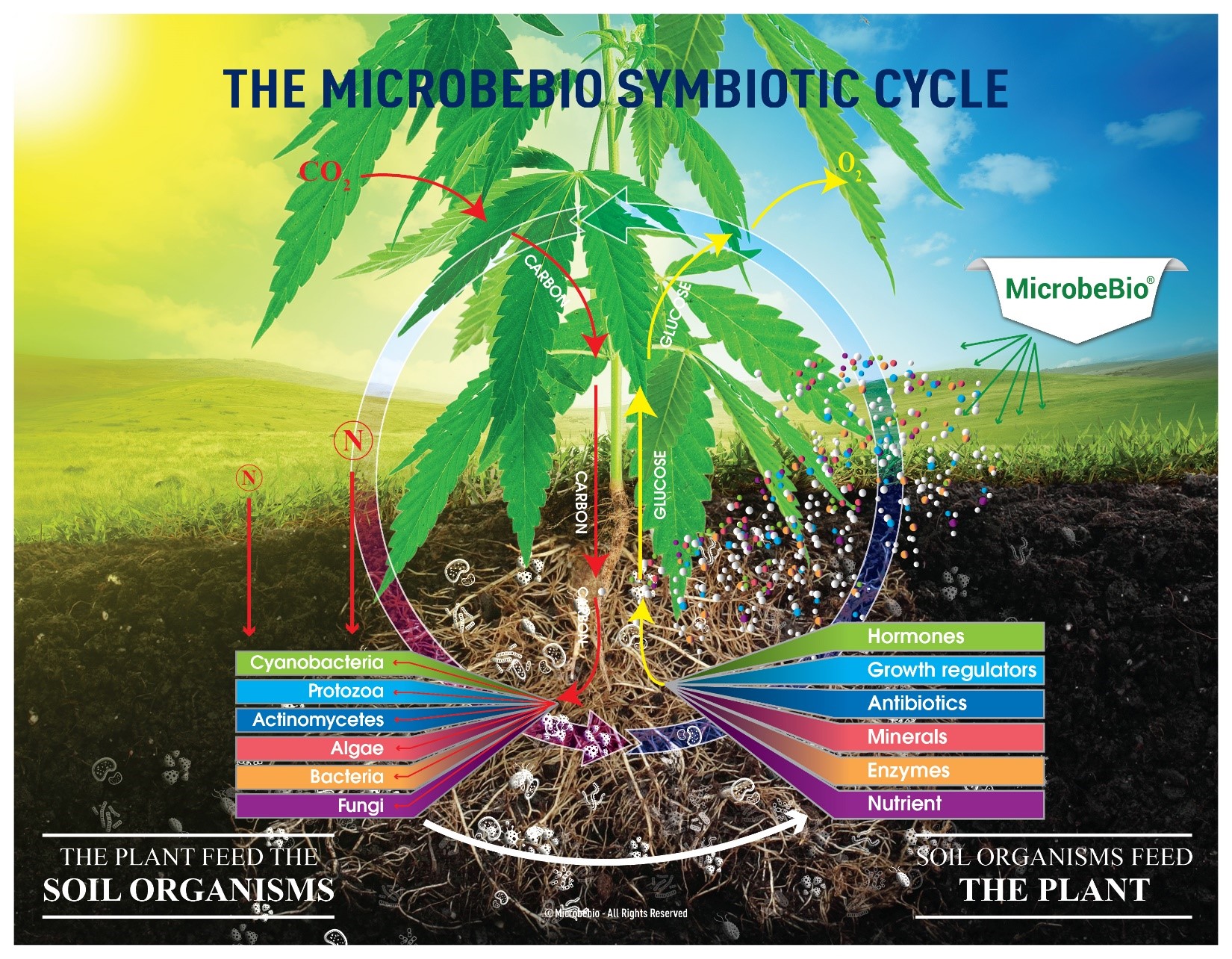
Nutrients from the product:
- Nitrogen is a component of many important organic compounds ranging from proteins to nucleic acids. The primary nutrient helps plant growing stronger and against plant pathogens.
- Phosphorus plays a central role in plants with energy transfer and protein metabolism against harmful fungi.
- Potassium helps in osmotic and ionic regulation. Potassium functions as a cofactor or activator for many enzymes of carbohydrate and protein metabolism that prevent parasitize all of the reproductive stages of plant pathogenic nematodes.
- Calcium is involved in cell division and plays a major role in the maintenance of membrane integrity. This is a vital element that helps plants grow and develop.
- Magnesium is known as a component of chlorophyll and a cofactor for many enzymatic reactions. The process will create the best protection on the leaf surface where the harmful pests or fungi hard to latch on.
- Sulfur is somewhat like phosphorus in that it is involved in plant cell energy that assists plants to reduce pathogenic nematodes and fungi.
- Iron is an essential component of many hemes and nonheme iron enzymes and carries, including the cytochromes (respiratory electron carriers) and the ferredoxins. The latter are involved in key metabolic functions such as Nitrogen fixation, photosynthesis, and electron transfer.
- Zinc is known as an essential component of several dehydrogenases, and peptidases, including carbonic anhydrase, alcohol dehydrogenase, glutamic dehydrogenase, and malic dehydrogenase, among others.
- Manganese is involved in the oxygen-evolving system of photosynthesis and is a component of the enzymes arginase and phosphorus transferases that is the best support for plants against pathogenic fungi and pests’ eggs.
- Copper is a constituent of several important enzymes, including cytochrome, oxidize ascorbic acid oxidase, and laccase.
- Boron involves in carbohydrate metabolism and synthesis of cell wall components that help plants against most the attack from plant pathogens.
- Molybdenum is required for the normal assimilation of nitrogen in plants. An essential component of nitrate reductase as well as nitrogenase (N2 fixation enzyme)
- Chlorine is essential for photosynthesis and is an activator of enzymes involved in splitting water. It also functions in the osmoregulation of plants growing on saline soils.
Using proprietary beneficial strains of microbes soil microbes to improve cannabis and hem growth:
Our microbial products contain an unparalleled proprietary formula of 50+ strains of microorganisms. The most notable difference between our line of microbial products and that of other manufacturers is encompassed in the following three words: Bio-diversity, Endospores, and Equilibrium
- Bio-Diversity: This chain of 50+ strains of bio-diverse microorganisms are critical for promoting nutrient cycling in soil when applied to the root zone or as a foliar treatment. By contrast, mono-cultural strains (without diversity) are susceptible to environmental pathogens and more easily succumb to lysing, denaturation of their DNA, and death The bio-active potential of these microbial spores (vs. “live” microbes which live and die), ensure a longer duration of nutrient uptake by plants throughout all phases of the growth cycle
- Endospores: Our products contain viable bacteria, sporulated via fermentation. Rationale: Spores (vs. active cells) limit metabolism and catabolism, thereby increasing shelf life and minimizing excessive genetic mutation of bacterial cells, which can lead to mutant cells that do not perform the way they were intended. Converting our products into endospores ensures fidelity (long-term activity), significantly reduces genetic mutations, and stabilizes the quality of the product. By contrast, the quality of viable (“live”/active) cells in a container risks jug expansion or compression due to excess metabolism of CO2 production in the container. Endospores are the preferred form due to their preservation, fidelity, quality assurance of performance in the field, and high shelf life.
- Equilibrium: After many QA trials, we believe that heterogeneity of microbes promotes a prolonged duration of soil balance, resulting in season-long composting by the bacteria. Biodiversity and redundancy allow for accelerated organic mineralization in the soil nutrient release, perimeter protection against pathogens, improved soil tilth leading to better air and water channeling
GROWING CANNABIS AND HEMP:
Variant types of root and soil microorganisms play the single most important role in increasing the types and amounts of terpenes a plant is capable of producing. The product not only contains 50+ proprietary strains of microbes that have been isolated from flowering plants in their natural growing environments and selected for their ability to stimulate terpenes and flavonoid production but also mingles with proprietary strains of microbes protecting cannabis and hemp from the pathogenic pests and insects.
Benefits from microbes:
- Bio-available for the significantly increased absorption of plants.
- Support the cannabis/hemp to produce more oils, remain healthy, and carry higher nutrient densities.
- Boosting flavonoid (antioxidants)
- Increasing terpene production and creating an enhanced flavor and aroma profile.
- Nurturing plant probiotics known as the future of flavorful nutrient density.
All proprietary beneficial fungi to support root mass:
The product contains fungi supporting root extensions and yeast involving in secretory pathways of antibodies against diseases. Moreover, these fungi play a major role in the soil aggregation process and stimulate microbial activity that assists plant build and support the plant’s natural immune system to protect the plant from plant pathogens from fungi.
All proprietary beneficial vitamin sources:
The product contains the natural “bio-stimulant” for soil organisms and plants that support certain biological activators, to help plant against most plant pathogens from harmful nematodes, fungi, and pests.
All beneficial organic matter (more than 45% OM):
Presenting the best organic matter sources that belong to OMRI Standards.
Promote plant symbiotic cycle & photosynthesis by the proprietary plant probiotic formula:
- The product also contains a plant hormone component that helps:
- Promotes nutritional growth, increases chlorophyll content, and fiber weight in plants.
- Promotes development of leaf buds and flowers activates chlorophyll content and helps roots develop depth
- Highly efficient for propagation and micro-rooting
- Activate nitrogen absorption
- Complete the condensation of dry matter in the leaves where photosynthesis takes place
- Increased content of photosynthesis and assimilation of carbon dioxide.
- Increases seed donation and chlorophyll content of leaves.
Plant hormones work best when they are mixed with phytonutrients (highly difficult extraction technology) that act on a broad spectrum of plant cells to:
- Regulates absorption of ions into plant cells and reduces the heavy metal accumulation
- Improves the growth and perfection of photosynthesis through an antioxidant system when plants are exposed to cold climates
- Minimize cell damage caused by oxidation caused by high-temperature stress
- Helps to reduce water stress thanks to the oxidative system that reduces evapotranspiration, stomatal conductivity, and MDA content in seedlings.
- Reduces stress in the root zone by increasing the structure of the sugar-based carbon chain.
- Protects crops from herbicides, fungicides, and pesticides due to the increased ability of carbon dioxide to assimilate antioxidant enzymes.
HOW MICROBEBIO® NATURE VIGOR WORKS:
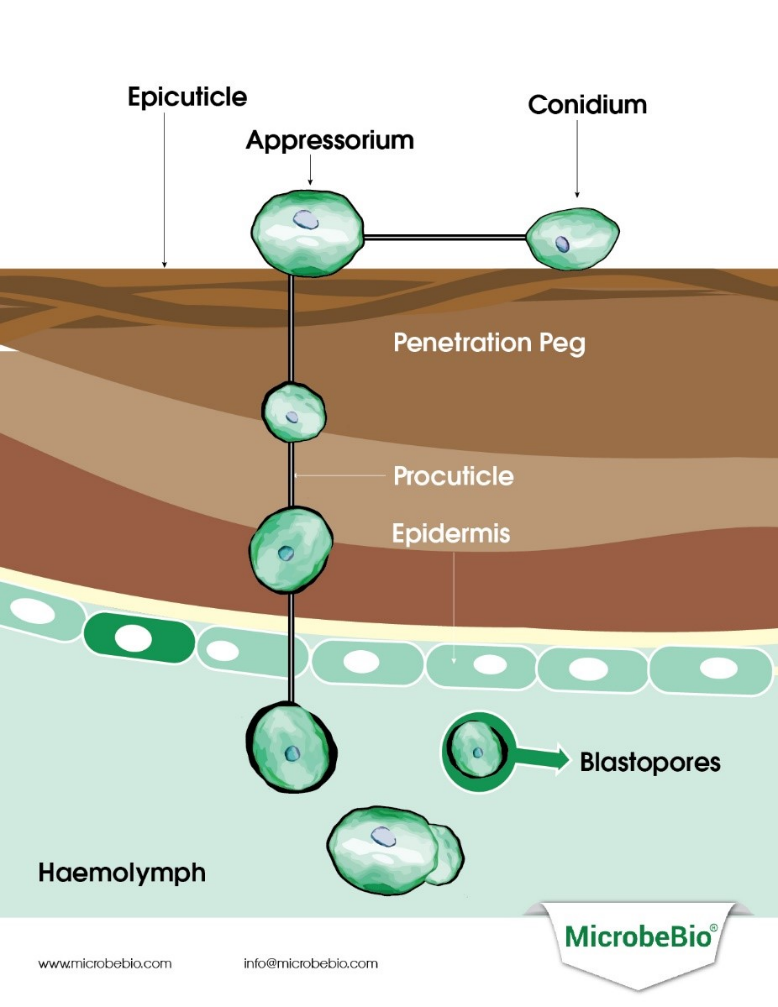
MicrobeBio® Nature Vigor ™ makes a protein precious crystal inside the spore that is harmful when devoured by specific bugs. This one-of-a-kind bacterium hinders the arrangement of the bug’s stomach that shields it from its stomach-related juices. It infiltrates the bug stomach, which at that point slaughters it through harming of the stomach substance and the spores themselves. MicrobeBio® Nature Vigor™ is harmless to birds, fish, and warm-blooded creatures because of their acidic gut conditions which could nullify the microbes’ impact. Water-use proficiency is improved because of expanded natural matter. There is no requirement for exceptional dealing with, this is a profoundly successful, prudent green option in contrast to caustic/harmful mixes. MicrobeBio® Nature Vigor™ is recommended to be applied directly to the infected areas to prevent population flare-ups.
These eco-safe microbial groups have good colonization abilities and production of endospores. The mutual interaction to plant to make bio-film to protect plant directly or indirectly to improving induce plant immunity against physical and biological environmental stresses and also stimulate to physiological and produce phytohormones. Biological control over plant areal fungal phytopathogen via colonization and defensive retention of phyllospheric niches are enabled by the production of bacterial allelochemicals, including iron-chelating siderophores, antibiotics, biocidal volatiles, lytic enzymes, and detoxification enzymes.
MicrobeBio® Nature Vigor™ spores, cyst & mycelia simply need to come in contact with a host. Once the host insect is infected, the microbes rapidly grow inside of the insect, feeding on the nutrients present in the host’s body and producing toxins in the process. When the host dies, the microbes cover the carcass in a layer of white mold that produces more infective spores.
Entomopathogenic fungi – contact adherence of conidia to cuticle; spore germination; penetration inside host; vegetative growth in host’s hemolymph; production of new conidia upon the death of the host.
HOW MICROBEBIO® NATURE VIGOR WORKS ON JAPANESE BEETLES:
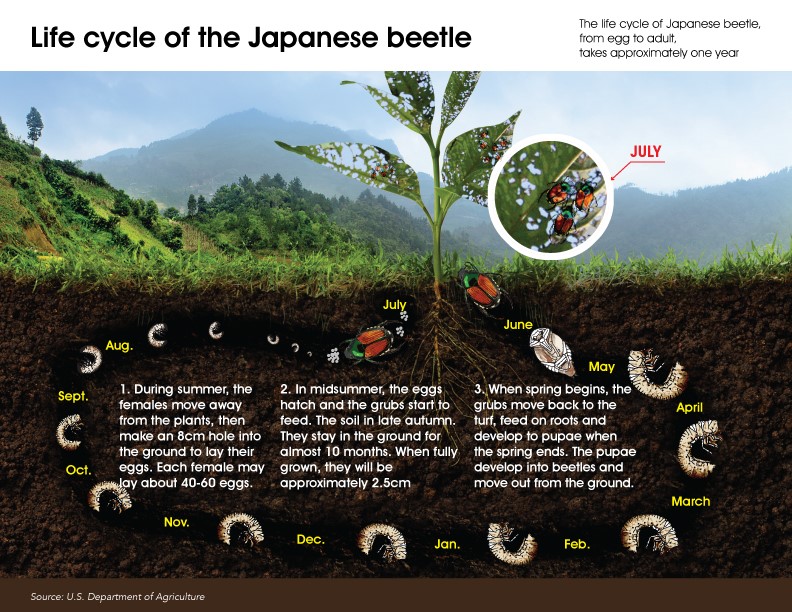
MicrobeBio® Nature Vigor contains immediately impacts the exoskeleton structure of the Japanese Beetle from the grub to adult stages. The product contains vital micro-organisms providing reasonable levels of prevention in generally safer than chemical insecticides and pesticides in the markets.
Special micro-organisms can break down lepidopterans or coleopterans of the insects or pests.
Special fungi grow naturally throughout the world and act as a parasite on various arthropod species. It is being used as biological insecticides or pesticides to control the number of tough pests such as termites, thrips, whiteflies, aphids, fall armyworms, Japanese beetles, and other different beetles.
HOW MICROBEBIO® NATURE VIGOR WORKS ON ARMYWORMS:
MicrobeBio® Nature Vigor™presents the eco-safe microbial group that has good colonization abilities and production of endospores. The mutual interaction to plant to make bio-film to protect plant directly or indirectly to improving induce plant immunity against physical and biological environmental stresses and also stimulate to physiological and produce phytohormones. Biological control over plant areal fungal phytopathogen via colonization and defensive retention of phyllosphere niches are enabled by the production of bacterial allelochemicals, including iron-chelating siderophores, antibiotics, biocidal volatiles, lytic enzymes, and detoxification enzymes.
MicrobeBio® Nature Vigor™ spores, cysts & mycelia simply need to come in contact with a host. Once the host insect is infected, the microbes rapidly grow inside of the insect, feeding on the nutrients present in the host’s body and producing toxins in the process. When the host dies, the microbes cover the carcass in a layer of white mold that produces more infective spores. Entomopathogenic fungi – contact adherence of conidia to cuticle; spore germination; penetration inside host; vegetative growth in host’s hemolymph; production of new conidia upon the death of the host.
MICROBEBIO® HYDRO ACTIVATOR™
Introduction:
MicrobeBio® Hydro Activator™ is an all-organic liquid fertilizer that was designed to promote the fruiting period and dramatically increase the Brix levels of productivity. MicrobeBio® Hydro Activator™ promotes earlier flowering and leads to larger blooms and fruit. Using MicrobeBio® Hydro Activator™ will greatly increase the quality of the product and slow the aging process. MicrobeBio® Hydro Activator™ is created with more than forty mineral elements, organic proteins, and essential amino acids that are made available for plants to uptake during the different stages of growth. It is packed full of the essential Macro and Micronutrients that are crucial for superior plant growth and development. You will see a major improvement in product quality when using MicrobeBio hydro activator – produce will look fresher, have healthier greener leaves, and will be significantly tastier, and have an increase in storage time.
Benefits:
- Immediately delivers primary nutrients (NPK) and renders them readily accessible for plant roots
- Furnishes a premium-selected sequential chain of sustainable, life-giving microbes for continuing soil and plant health
- Stimulates significant bio-mass (root) growth which is essential for plant health and growth
- Enhances plant BRIX levels (sugars) to enrich the bio-available food source for soil microbes
- Remediates salinity and heavy metal contamination in soils
- Improves water retention (by expanding the root system) and increases drought tolerance
- Balances pH in acid or alkaline conditions for optimal nutrient uptake
- Maintains a C:N Ratio (Carbon & Nitrogen) by activating microbes to release nutrients such as nitrogen, phosphorus, and zinc to crops
- Boosts chlorophyll content in leaves to invigorate the photosynthesis process
- Acts as a powerful prophylactic by preventing harmful Rhizoctonia and fusarium spores from germinating.
- Is comprised of 100% eco-friendly elements, which are non-toxic and are safe to use around children, adults, pets, and livestock.
Middle flowering phase (est. week 4 after the vegetative phase)
Recommended products:
- MicrobeBio® Nature Phenom:
The product comprises 100% organic nutrient-rich ingredients infused with value-added biologicals performed to be effective for providing the nutrients and protect cannabis plants up to harvesting time.
-
- Apply 4 kg per hectare. Please follow the application on the label.
- Require the minimum macronutrients ratio at 5:7:10
- Week 3: All branches including top stems should be pure green. Growth should be vigorous and explosive at every node which will transfer into heavy yields. Foliage now extremely dense on short stocky internodes that produces a dense top canopy that obscures any lower stalks
- Week 4: The main cola can have as many as 20 pistils. The main cola will produce the largest buds.
Mid-late flowering phase (est. week 6 after the vegetative phase)
- Require the minimum macronutrients ratio at 4:7:10
- Continue to feed high phosphorous. Production of leaves has now slowed down due to a good leaching rinse during the previous week which has created a low status of N in the media and a high reserve of P to enhance flower production. Provide the optimal condition by managing water and sunlight.
- The large heavy colas are a result of adequate sunlight. Its cultural practices have gone as scheduled, denes heavy colas on both main and second stems are quite evident. The buds have reached full size.
Late flowering phase (est. week 7 to week 8 after the vegetative phase)
- By this stage, the buds on cannabis plants should be dense, firm, and coated with a thick layer of trichomes. The trichomes should be transitioning from completely clear to milky white, with a select few turning ambers. This is a telltale sign harvest is here. The growers can verify this by “zooming in” on them using a pocket scope or magnifying glass. The pistils will continue to get darker during these final weeks too—another sign that cannabis plants are almost ready for harvest.
- In these final weeks, phosphorus, potassium, and calcium are still your most important nutrients. Two weeks before harvest, however, you’ll want to flush your plants with plain, pH-balanced water. This encourages them to take up all remaining nutrients and helps preserve the natural flavor of your buds.
- During this last flush, your plants will develop some yellow leaves as they consume all the remaining nutrients stored in their foliage.
FLUSHING CARE
Once the growers stop feeding, the cannabis plants will take up whatever nutrients remain in the growing medium. Then, they will start to suck their leaves dry to get the nutrients out from these as well. This is why the cannabis plant will turn yellow in late flowering. Not needing to feed the plants in the last couple of weeks provides an extra perk—it saves you money on nutrient expenses.
During these two weeks, the growers can periodically flush your medium with pure, pH-balanced water to get rid of any mineral deposits lingering in the soil. Make sure to drench the soil to full capacity so it picks up the nutrients, then drench it again and let it all drain out the bottom for a couple of minutes. Make sure not to water too frequently.
MICROBEBIO® NATURE PHENOM™
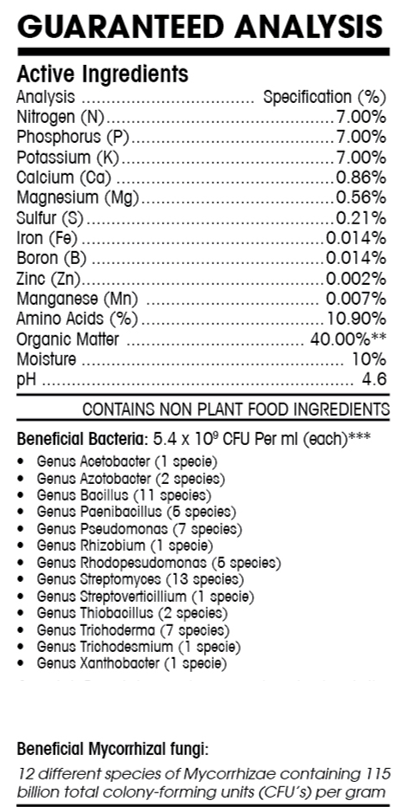
MicrobeBio® Nature Phenom™ is an all-organic bio fertilizer using a proprietary biological finishing technique to deliver billions of beneficial microorganism specially selected for strong microbial adaptability with complete growth boost package derived from all-organic land plant materials, vital minerals mined from the Earth, ocean plants, crucial vitamins, natural plant hormones, essential sugars, vital amino acids, organic carbons and proteins, that are essential to immediately initiate microbial colonization. Nature Phenom is able to enter the foliage and the root zone quickly to stimulate photosynthesis process and boost symbiotic cycle. Nature Phenom improves plant response, enhance natural plant defense mechanism, balance soil biological, and increase root systems which further improves the soil and reduces water use.
MicrobeBio® Nature Phenom™ provides the biology necessary to solubilize nutrients and fix nitrogen to meet the plant demands while improving stress/drought tolerance, improves seed germination and increases root development. This product increases and stabilizes chlorophyll, which results in darker green leaves and increased sugar content in plants and aids in salt-resistance to optimize soil environment and plant growth. MicrobeBio® Nature Phenom™ will not burn and is completely safe for all life forms.
MicrobeBio® Nature Phenom™ probiotic function allows farmers to increase plant vigor, and thus imparts resistance to insect attacks helping to reduce operation cost and the need for chemical compounds and pesticides. This balanced and multi-functional product will greatly promote healthy soil while increasing crop yields and produce quality
Benefits:
- Reduce adverse environmental impacts
- Heal and protect soil
- Boost root vitality, seed germination, crop yields, and drought resistance
- Unique molecules bind with plants and aid roots in receiving water and nutrients
- Dramatically increases yields due to optimized nutrition
- Enhances soil Cation Exchange Capacity (CEC) – a useful indicator of soil fertility that reflects the soil’s ability to supply three important plant nutrients: calcium, magnesium and potassium
- Remineralizes soil that has been leached
- Aids sandy soils in retaining water and ionized nutrients when arid conditions prevail and hummus is lacking
- Organically chelates microelements in alkaline soils which increases their availability for plants
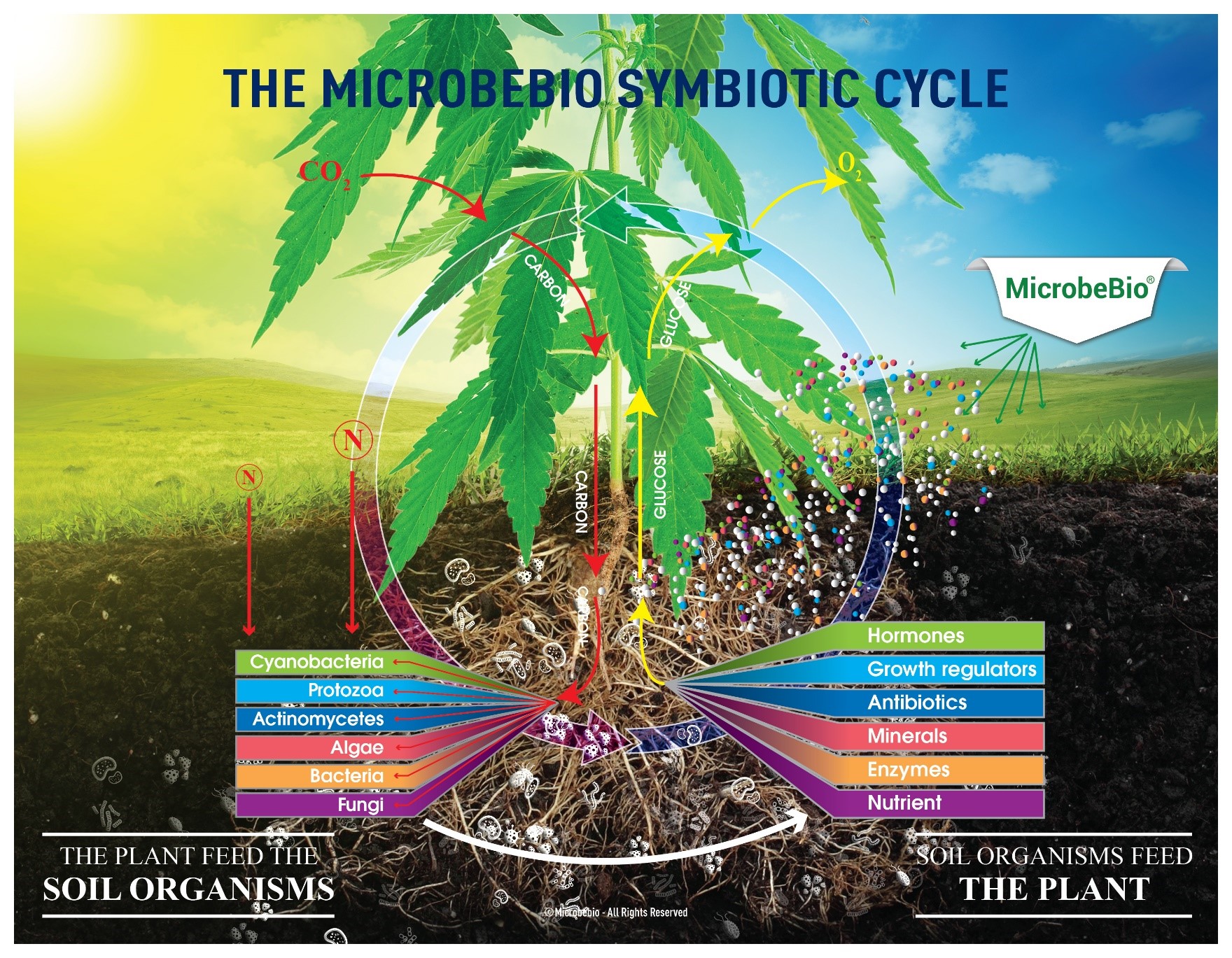
Nutrients from the product:
- Nitrogen is a component of many important organic compounds ranging from proteins to nucleic acids. The primary nutrient helps plant growing stronger and against plant pathogens.
- Phosphorus plays a central role in plants with energy transfer and protein metabolism against harmful fungi.
- Potassium helps in osmotic and ionic regulation. Potassium functions as a cofactor or activator for many enzymes of carbohydrate and protein metabolism that prevent parasitize all of the reproductive stages of plant pathogenic nematodes.
- Calcium is involved in cell division and plays a major role in the maintenance of membrane integrity. This is a vital element that helps plants grow and develop.
- Magnesium is known as a component of chlorophyll and a cofactor for many enzymatic reactions. The process will create the best protection on the leaf surface where the harmful pests or fungi hard to latch on.
- Sulfur is somewhat like phosphorus in that it is involved in plant cell energy that assists plants to reduce pathogenic nematodes and fungi.
- Iron is an essential component of many hemes and nonheme iron enzymes and carries, including the cytochromes (respiratory electron carriers) and the ferredoxins. The latter are involved in key metabolic functions such as Nitrogen fixation, photosynthesis, and electron transfer.
- Zinc is known as an essential component of several dehydrogenases, and peptidases, including carbonic anhydrase, alcohol dehydrogenase, glutamic dehydrogenase, and malic dehydrogenase, among others.
- Manganese is involved in the oxygen-evolving system of photosynthesis and is a component of the enzymes arginase and phosphorus transferases that is the best support for plants against pathogenic fungi and pests’ eggs.
- Copper is a constituent of several important enzymes, including cytochrome, oxidize ascorbic acid oxidase, and laccase.
- Boron involves in carbohydrate metabolism and synthesis of cell wall components that help plants against most the attack from plant pathogens.
- Molybdenum is required for the normal assimilation of nitrogen in plants. An essential component of nitrate reductase as well as nitrogenase (N2 fixation enzyme)
- Chlorine is essential for photosynthesis and is an activator of enzymes involved in splitting water. It also functions in the osmoregulation of plants growing on saline soils.
Using proprietary beneficial strains of microbes soil microbes to improve cannabis and hem growth:
Our microbial products contain an unparalleled proprietary formula of 50+ strains of microorganisms. The most notable difference between our line of microbial products and that of other manufacturers is encompassed in the following three words: Bio-diversity, Endospores, and Equilibrium
- Bio-Diversity: This chain of 50+ strains of bio-diverse microorganisms are critical for promoting nutrient cycling in soil when applied to the root zone or as a foliar treatment. By contrast, mono-cultural strains (without diversity) are susceptible to environmental pathogens and more easily succumb to lysing, denaturation of their DNA, and death The bio-active potential of these microbial spores (vs. “live” microbes which live and die), ensure a longer duration of nutrient uptake by plants throughout all phases of the growth cycle
- Endospores: Our products contain viable bacteria, sporulated via fermentation. Rationale: Spores (vs. active cells) limit metabolism and catabolism, thereby increasing shelf life and minimizing excessive genetic mutation of bacterial cells, which can lead to mutant cells that do not perform the way they were intended. Converting our products into endospores ensures fidelity (long-term activity), significantly reduces genetic mutations, and stabilizes the quality of the product. By contrast, the quality of viable (“live”/active) cells in a container risks jug expansion or compression due to excess metabolism of CO2 production in the container. Endospores are the preferred form due to their preservation, fidelity, quality assurance of performance in the field, and high shelf life.
- Equilibrium: After many QA trials, we believe that heterogeneity of microbes promotes a prolonged duration of soil balance, resulting in season-long composting by the bacteria. Biodiversity and redundancy allow for accelerated organic mineralization in the soil nutrient release, perimeter protection against pathogens, improved soil tilth leading to better air and water channeling.
GROWING CANNABIS AND HEMP:
Variant types of root and soil microorganisms play the single most important role in increasing the types and amounts of terpenes a plant is capable of producing. The product contains 50+ proprietary strains of microbes that have been isolated from flowering plants in their natural growing environments and selected for their ability to stimulate terpene and flavonoid production.
Benefits from microbes:
- Bio-available for the significantly increased absorption of plants.
- Support the cannabis/hemp to produce more oils, remain healthy, and carry higher nutrient densities.
- Boosting flavonoid (antioxidants)
- Increasing terpene production and creating an enhanced flavor and aroma profile.
- Nurturing plant probiotics known as the future of flavorful nutrient density.
All proprietary beneficial fungi to support root mass:
The product contains fungi supporting root extensions and yeast involving in secretory pathways of antibodies against diseases. Moreover, these fungi play a major role in the soil aggregation process and stimulate microbial activity that assists plant build and support the plant’s natural immune system to protect the plant from plant pathogens from fungi.
All proprietary beneficial vitamin sources:
The product contains the natural “bio-stimulant” for soil organisms and plants that support certain biological activators, to help plant against most plant pathogens from harmful nematodes, fungi, and pests.
All beneficial organic matter (more than 45% OM):
Presenting the best organic matter sources that belong to OMRI Standards.
Promote plant symbiotic cycle & photosynthesis by the proprietary plant probiotic formula:
- The product also contains a plant hormone component that helps:
- Promotes nutritional growth, increases chlorophyll content, and fiber weight in plants.
- Promotes development of leaf buds and flowers activates chlorophyll content and helps roots develop depth
- Highly efficient for propagation and micro-rooting
- Activate nitrogen absorption
- Complete the condensation of dry matter in the leaves where photosynthesis takes place
- Increased content of photosynthesis and assimilation of carbon dioxide.
- Increases seed donation and chlorophyll content of leaves.
Plant hormones work best when they are mixed with phytonutrients (highly difficult extraction technology) that act on a broad spectrum of plant cells to:
- Regulates absorption of ions into plant cells and reduces the heavy metal accumulation
- Improves the growth and perfection of photosynthesis through an antioxidant system when plants are exposed to cold climates
- Minimize cell damage caused by oxidation caused by high-temperature stress
- Helps to reduce water stress thanks to the oxidative system that reduces evapotranspiration, stomatal conductivity, and MDA content in seedlings.
- Reduces stress in the root zone by increasing the structure of the sugar-based carbon chain.
- Protects crops from herbicides, fungicides, and pesticides due to the increased ability of carbon dioxide to assimilate antioxidant enzymes.
HARVESTING
The signal starts harvesting:
The fan leaves will start yellow.

Trichome begins to change the appearance.

Calyxes present plump.

Stigmas (pistils) turn to a darker color.

CONCLUSION:
The MicrobeBio® product’s lines are an all-natural and organic fertilizer that promotes the growth of beneficial microbes and improves the nutrient uptake for the roots of your plants. The MicrobeBio® product’s lines are enhanced with mycorrhizae and beneficial microbes which have been primarily stimulating the growth of your plant roots.
The all-natural and organic fertilizer contains both primary and secondary nutrients to boost the growth and health of your cannabis plants. Once applies, millions upon millions of these beneficial microbes and bacteria make their way to the roots of your plants providing it with a greater increase in water and nutrient absorption efficiency.
At MicrobeBio®, we are committed to improving the productivity of the soil by offering products that are affordable and eco-friendly.
Think of MicrobeBio® products like this – We’re the health food of plant food, and we’re here to put an end to all of the horticultural junk-food that has been shoved down Mother Nature’s gullet for far too long. You might say that MicrobeBio has taken the very best of Mother Nature and put it into a concentrated form, and like all-natural products should be, we never use growth hormones or GMOs, never irradiate, and we never use any chemicals that are harmful to humans, livestock or the planet.
